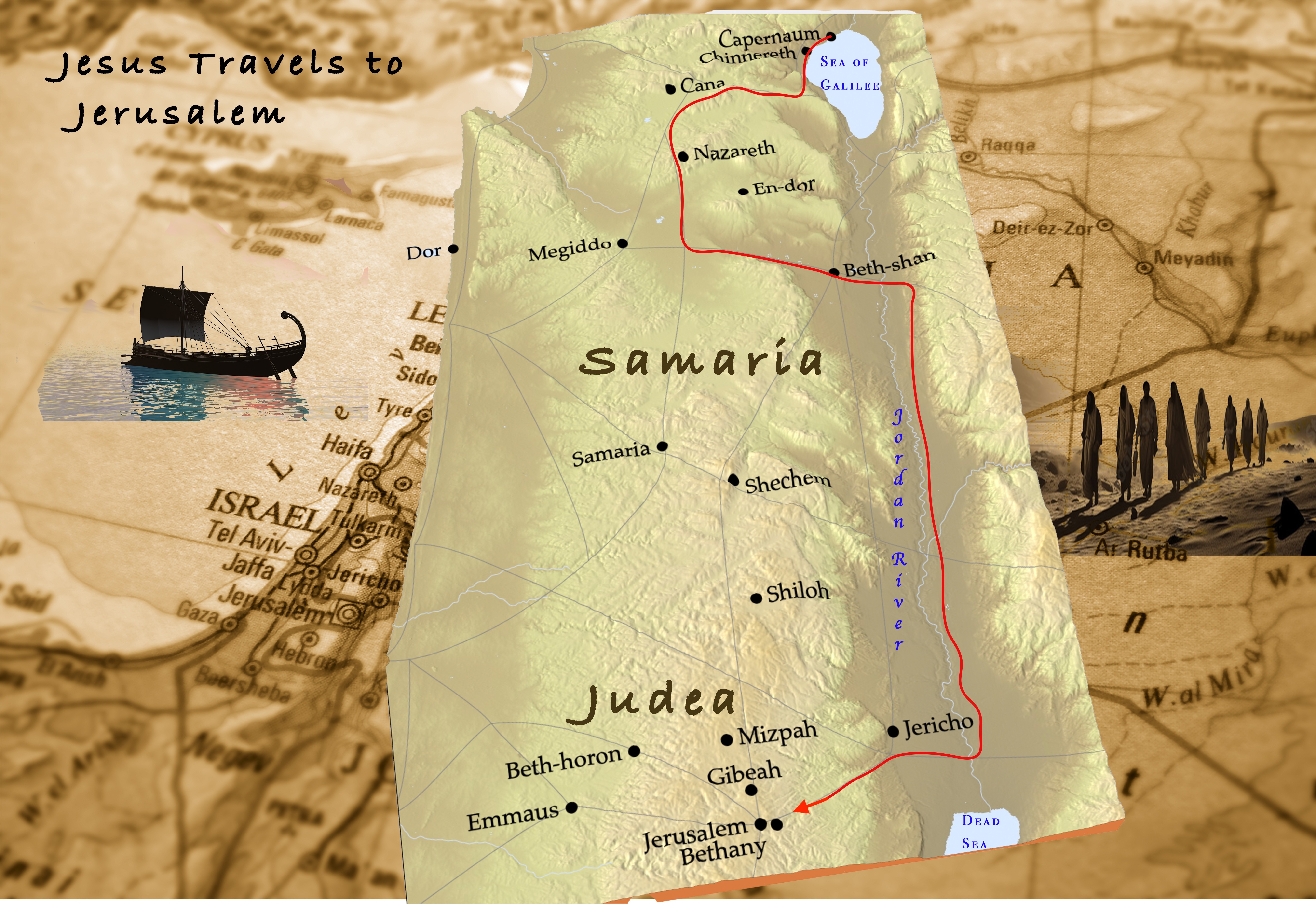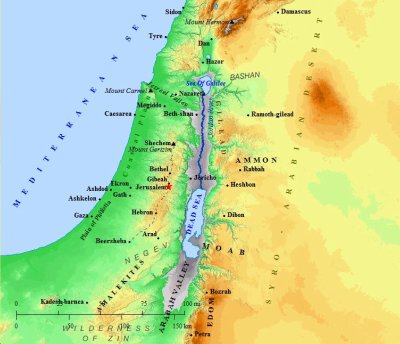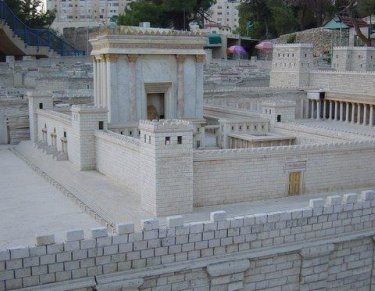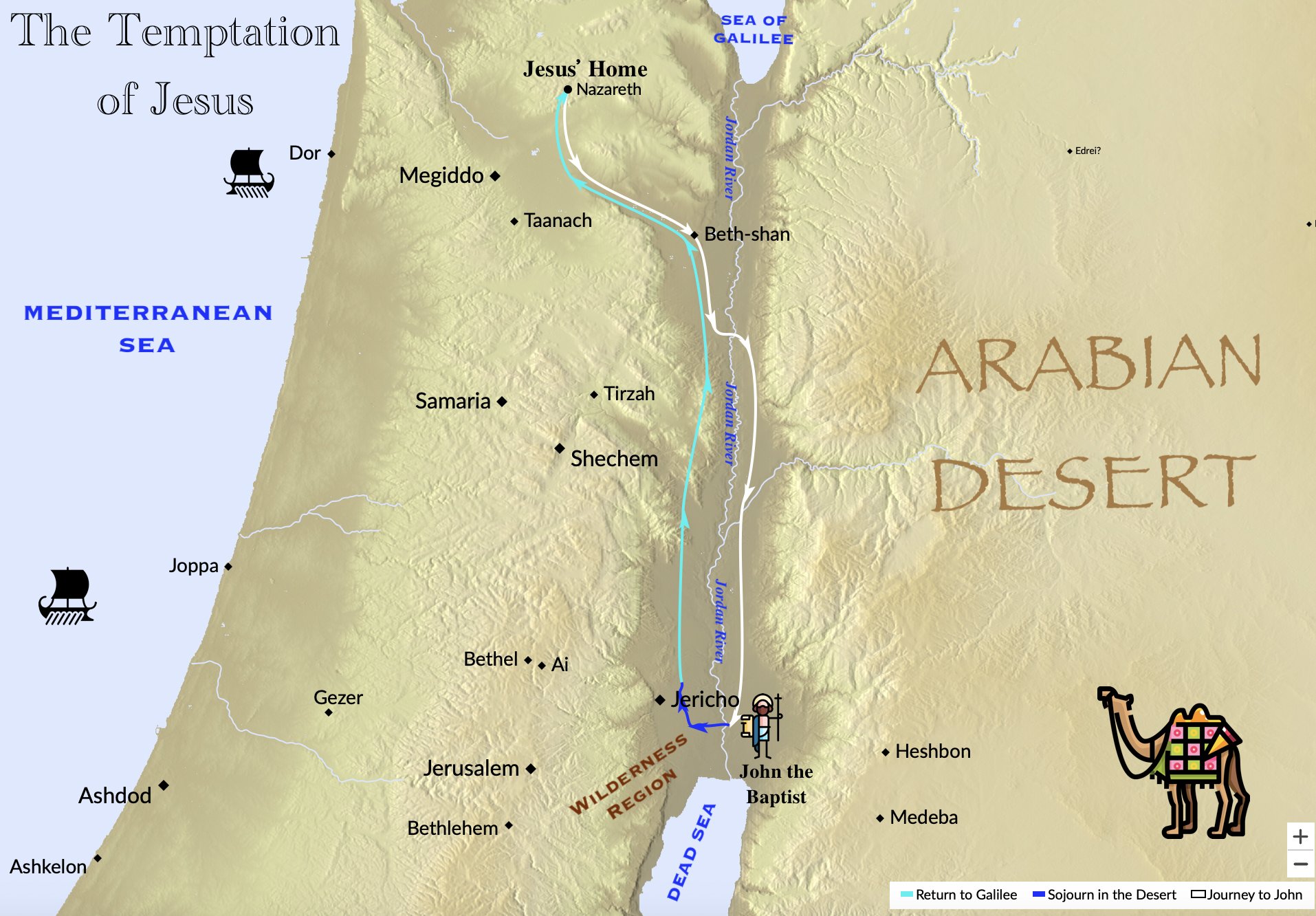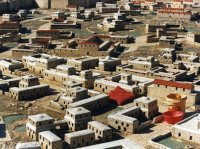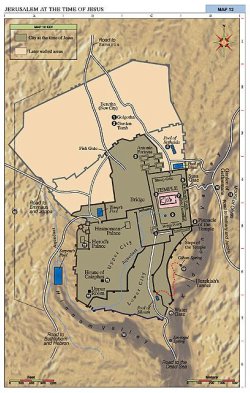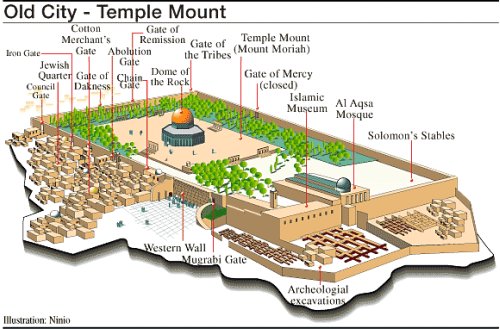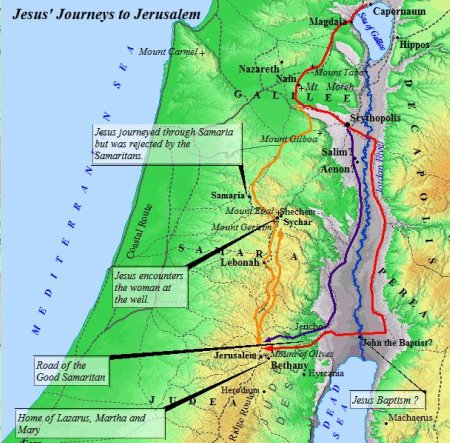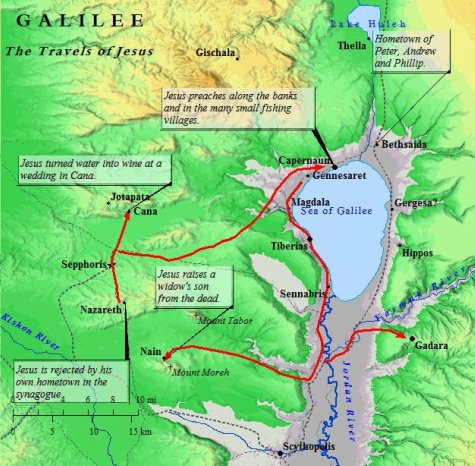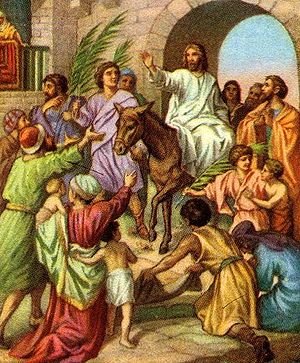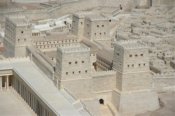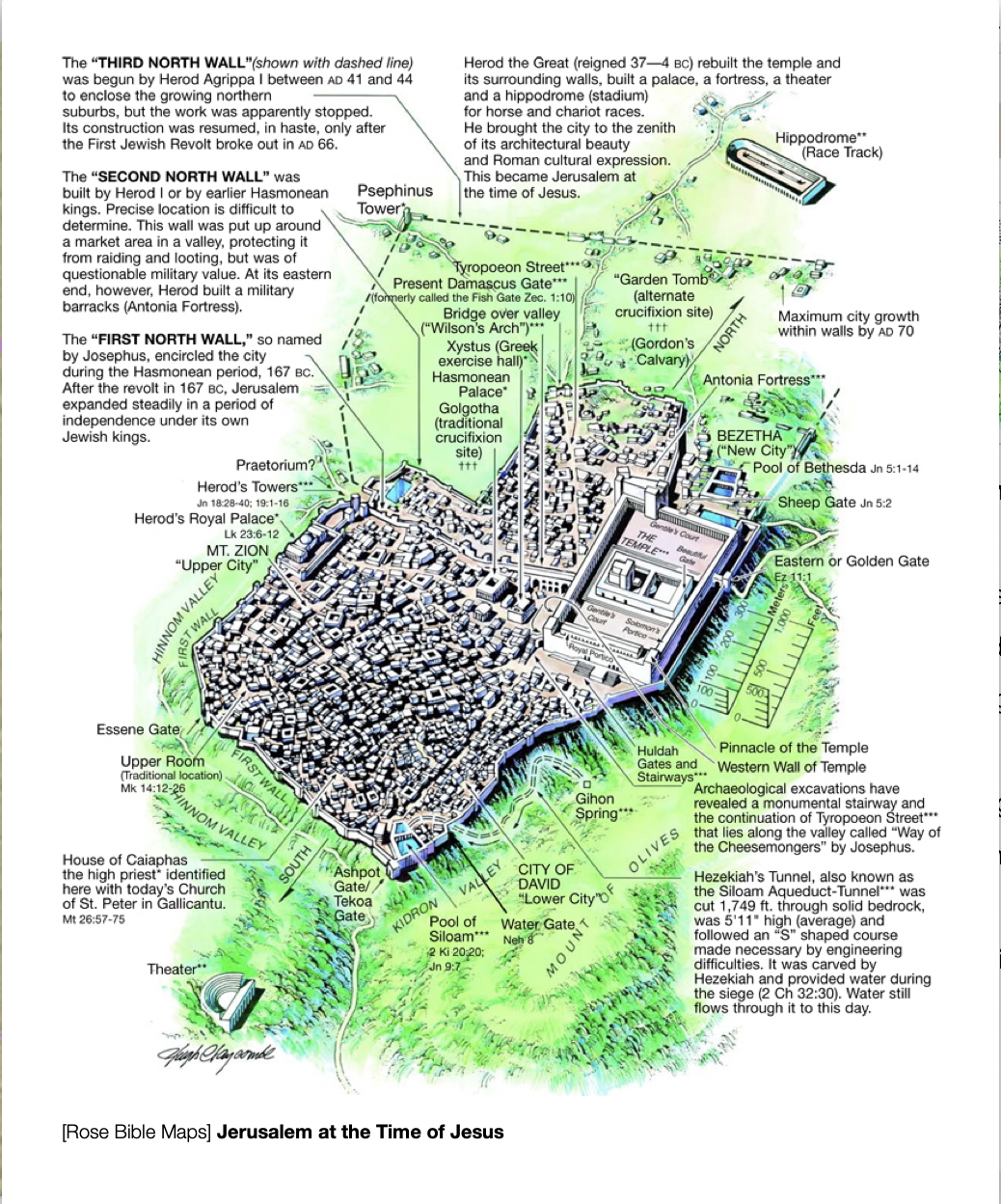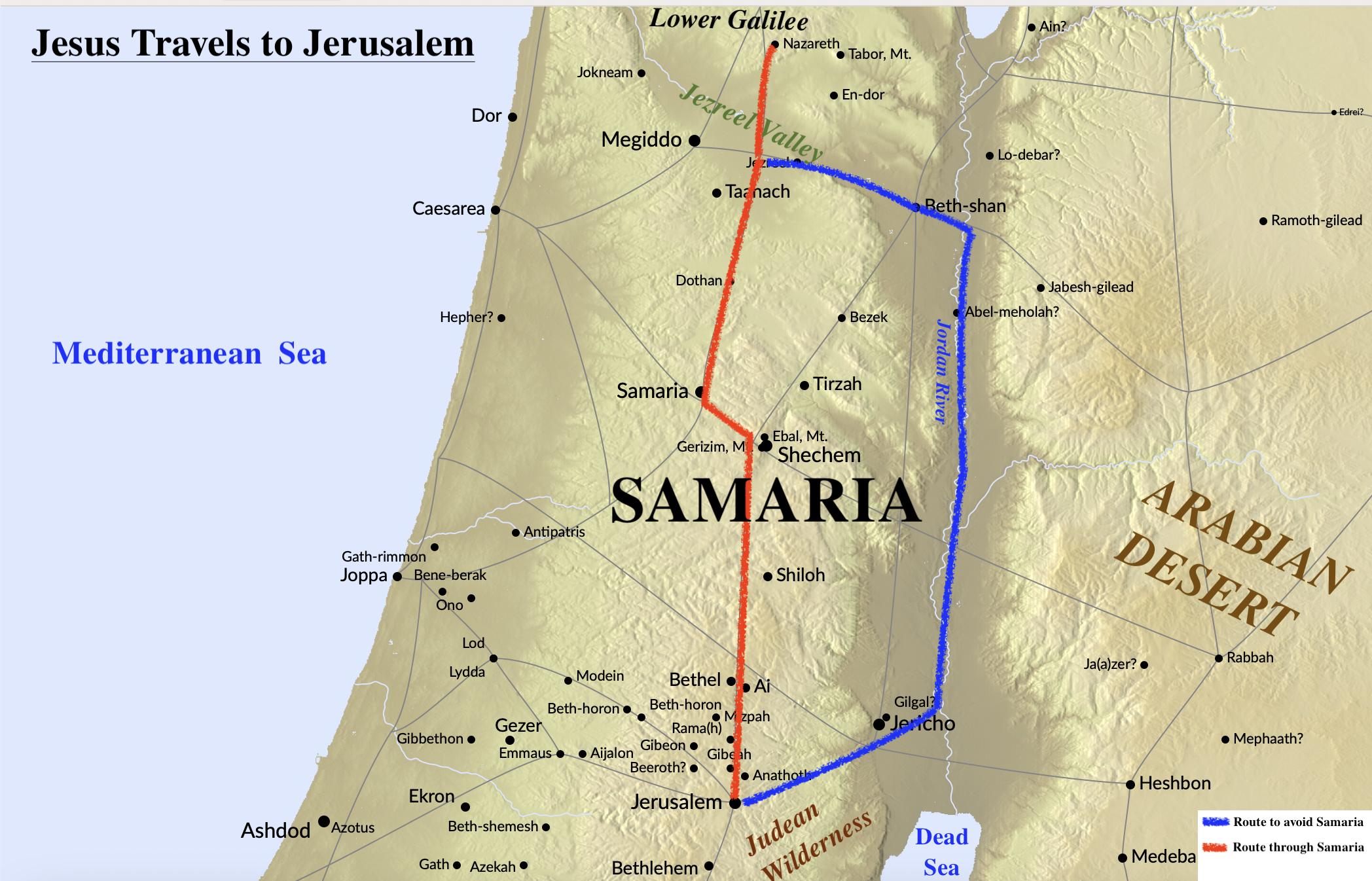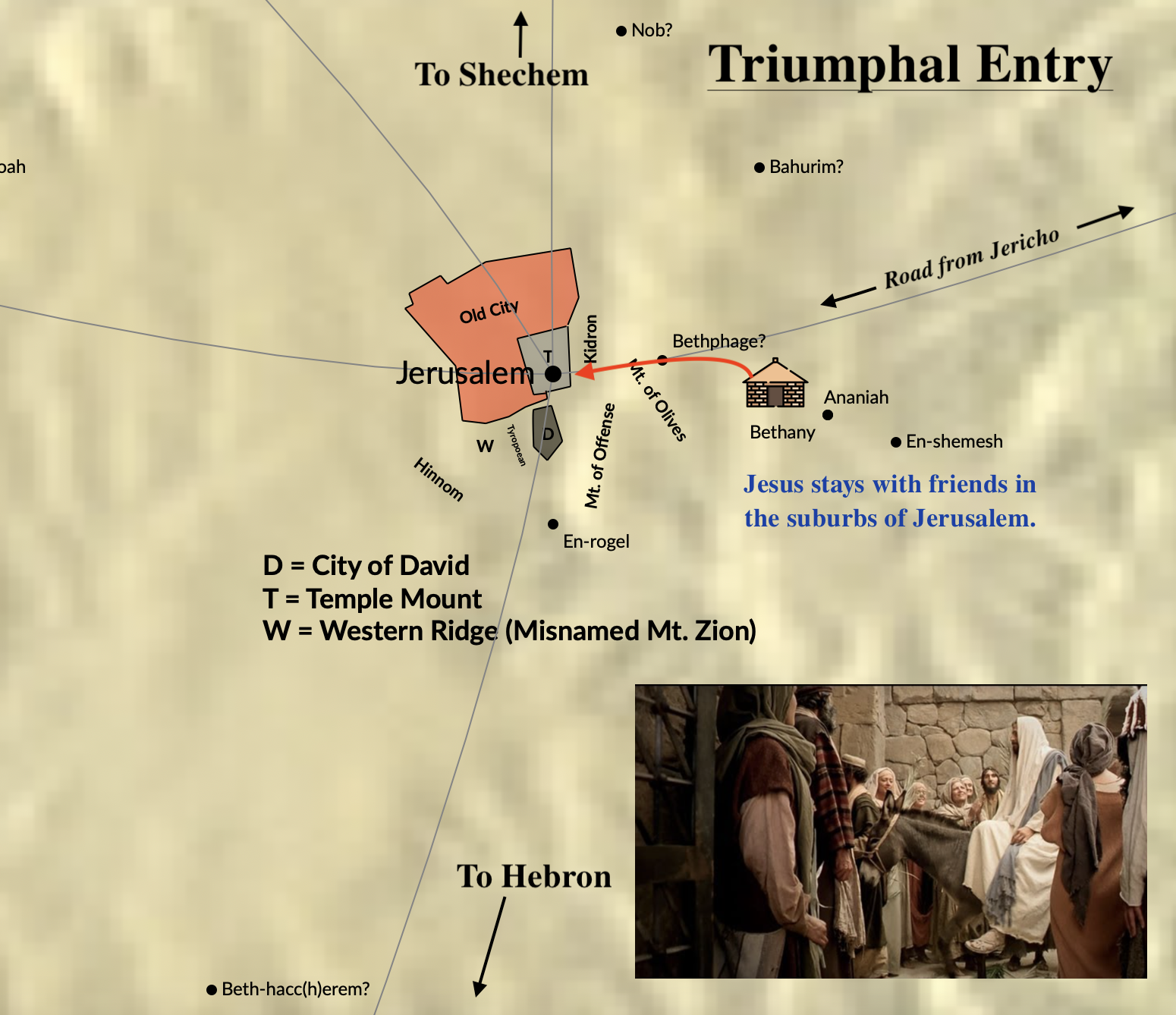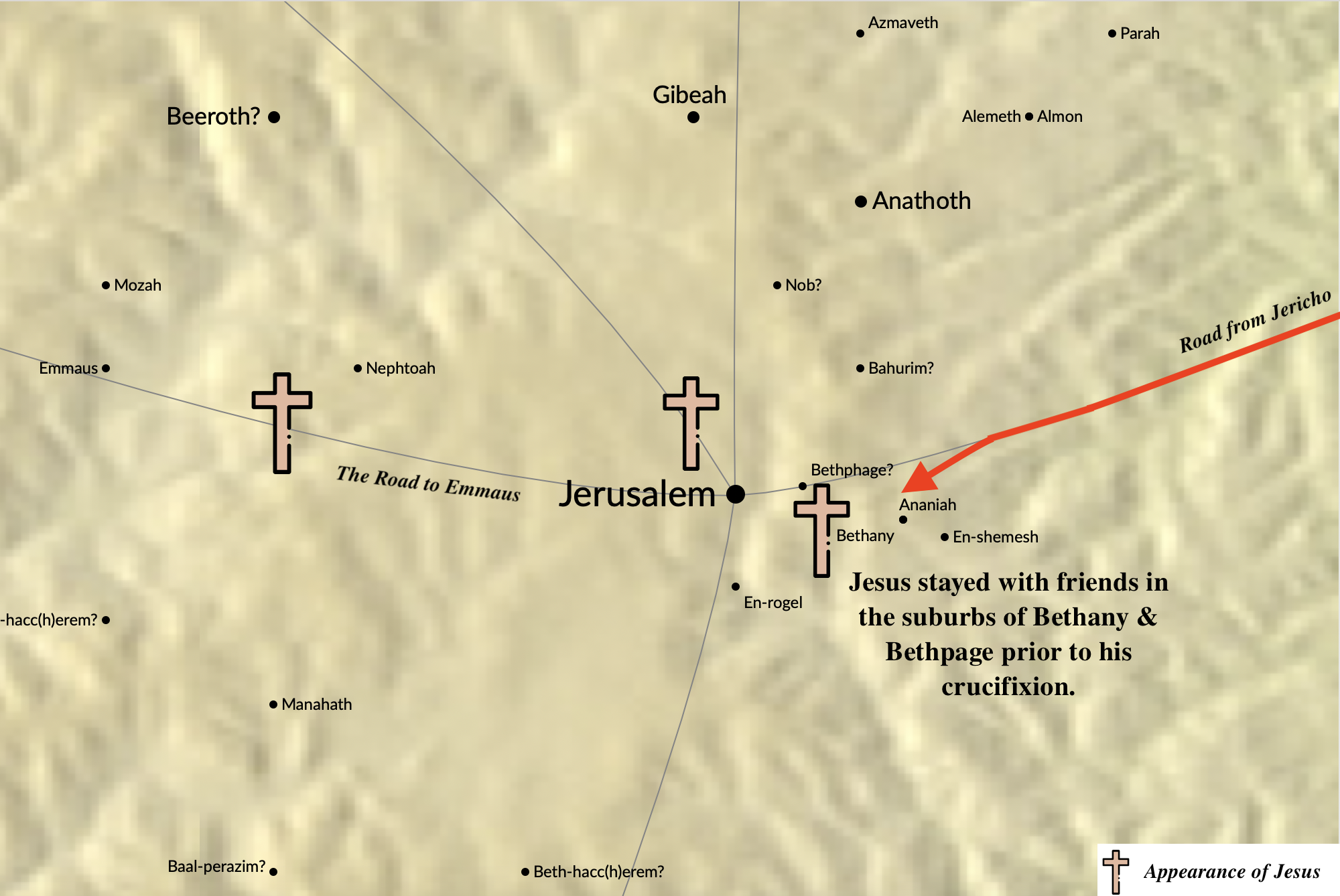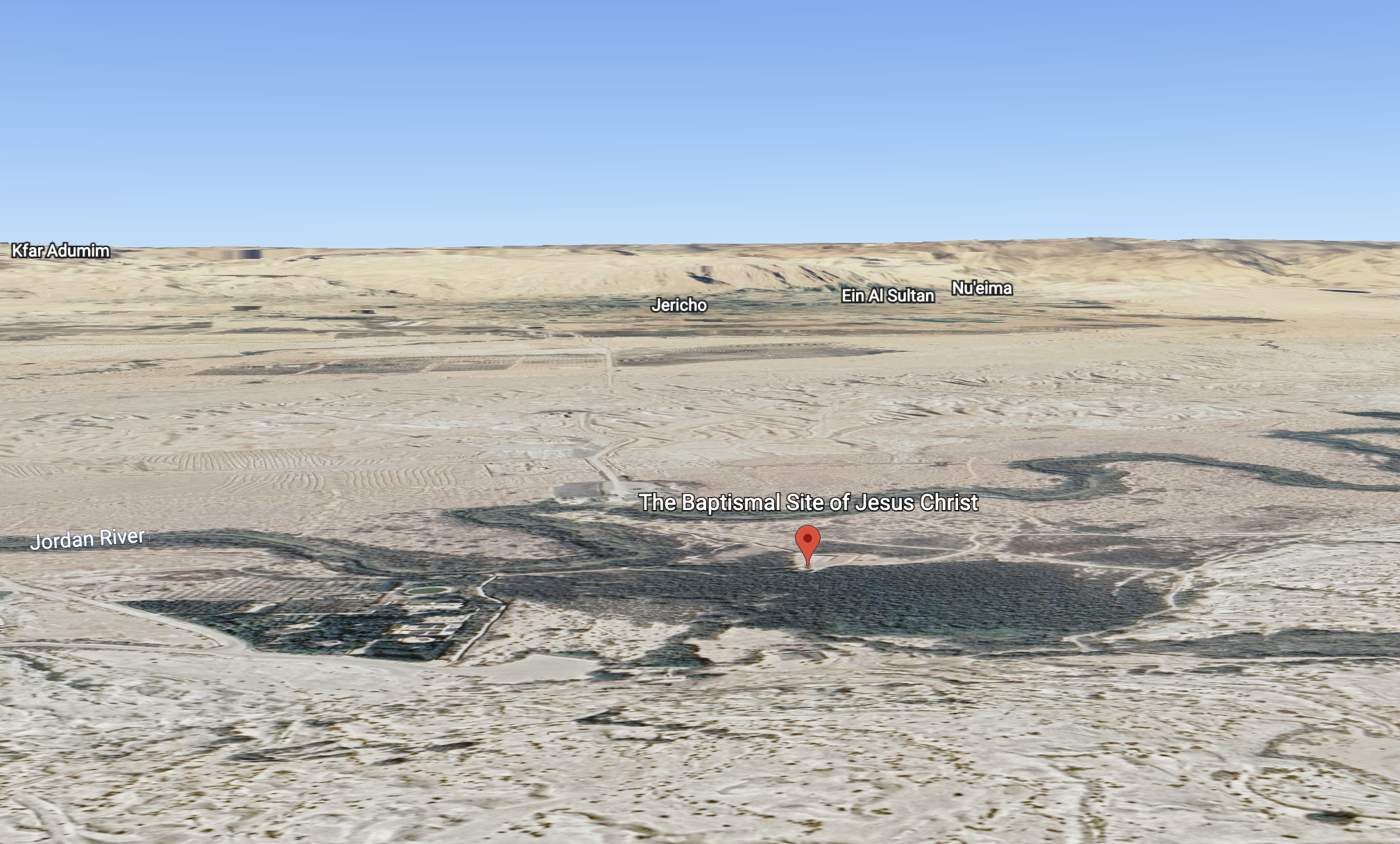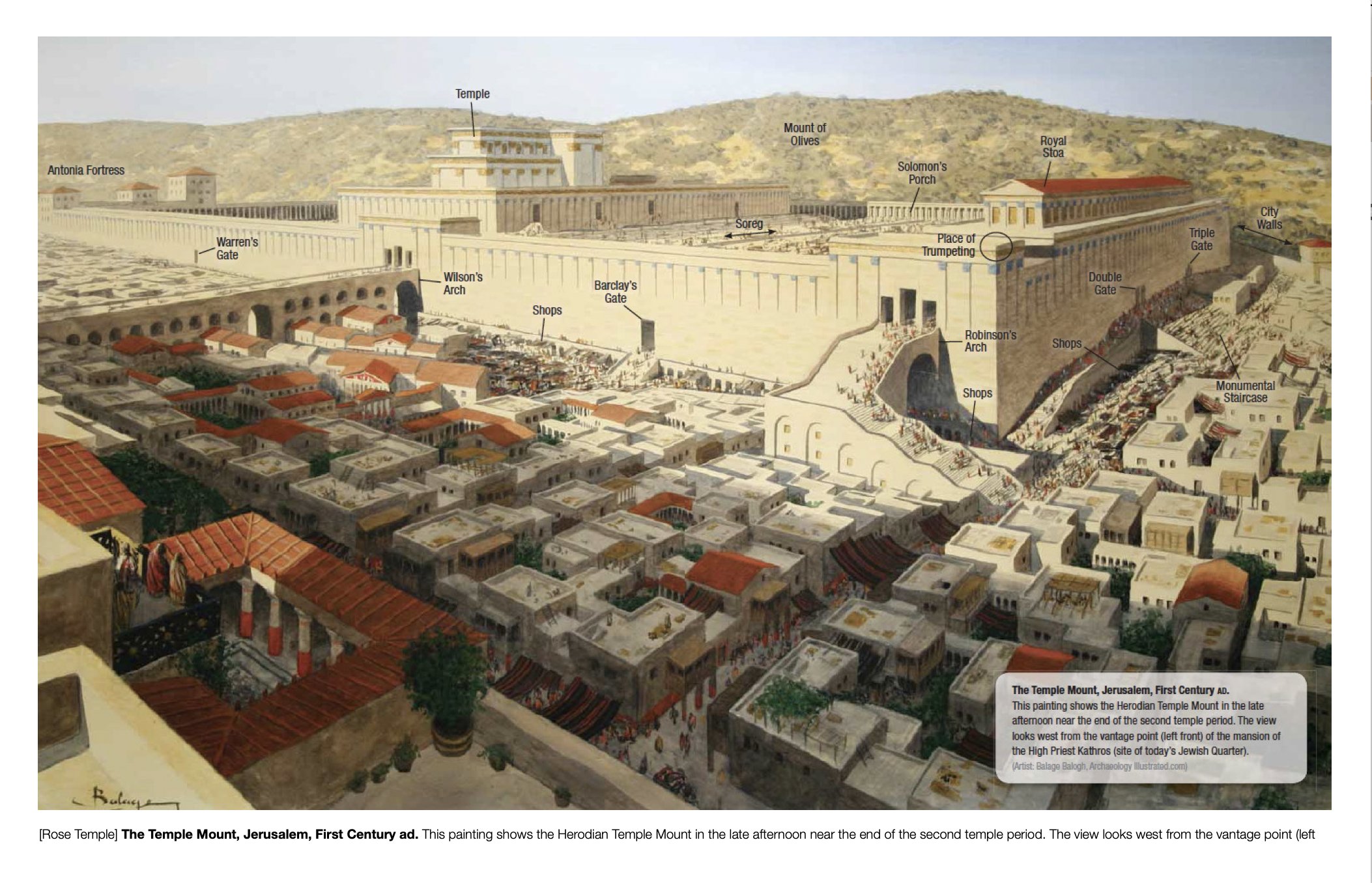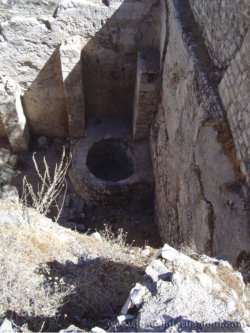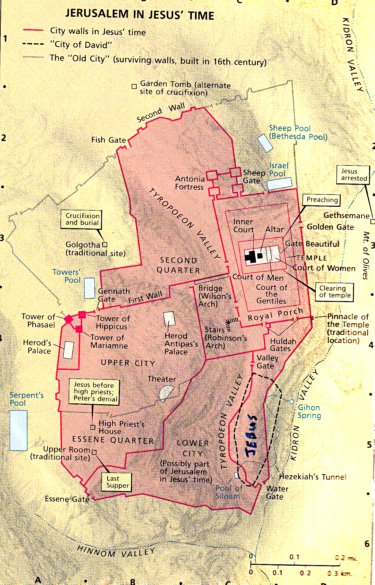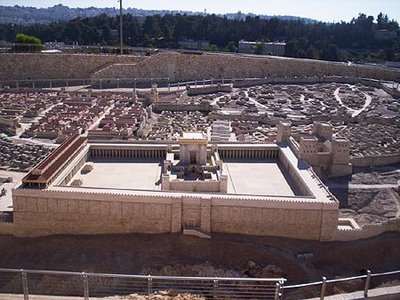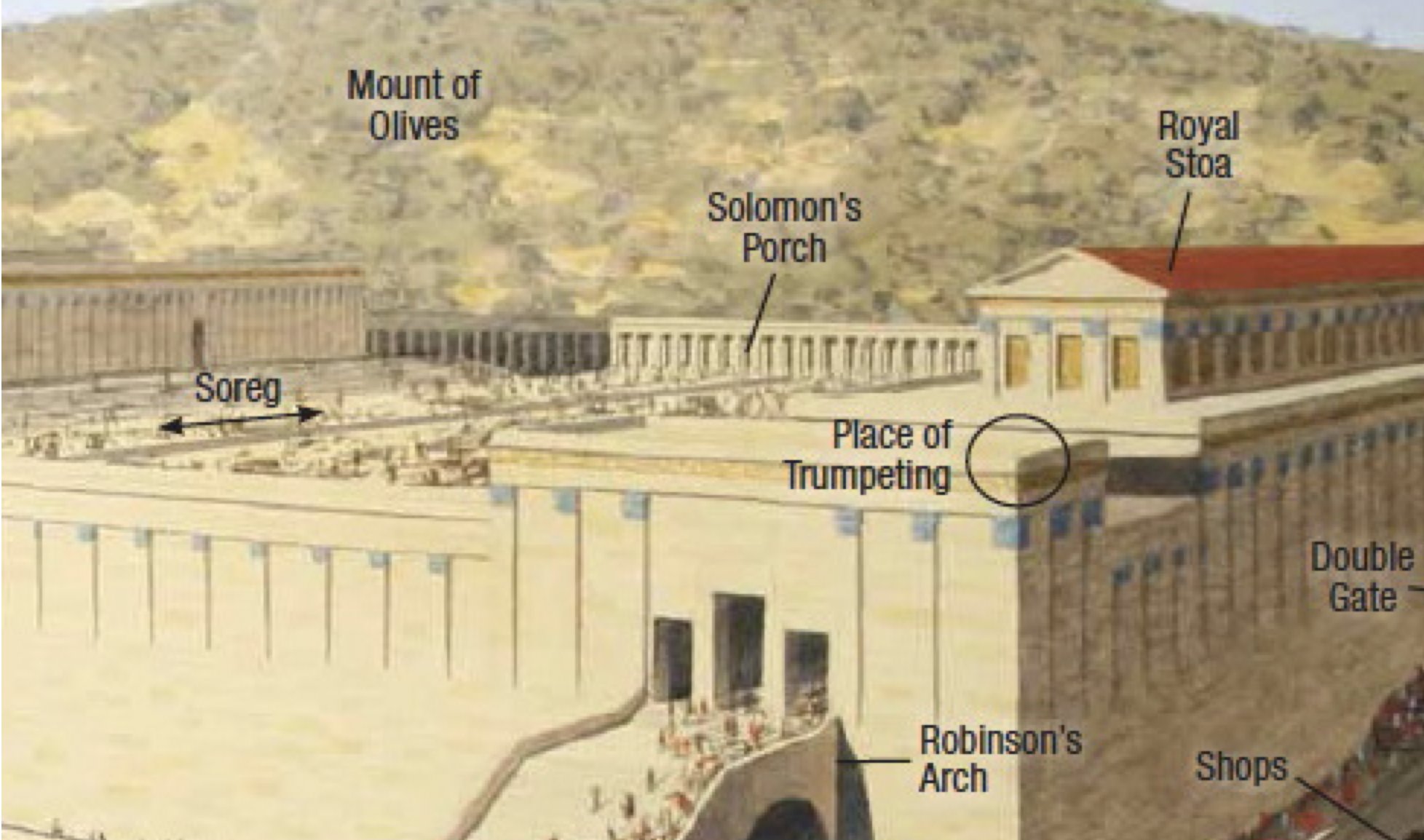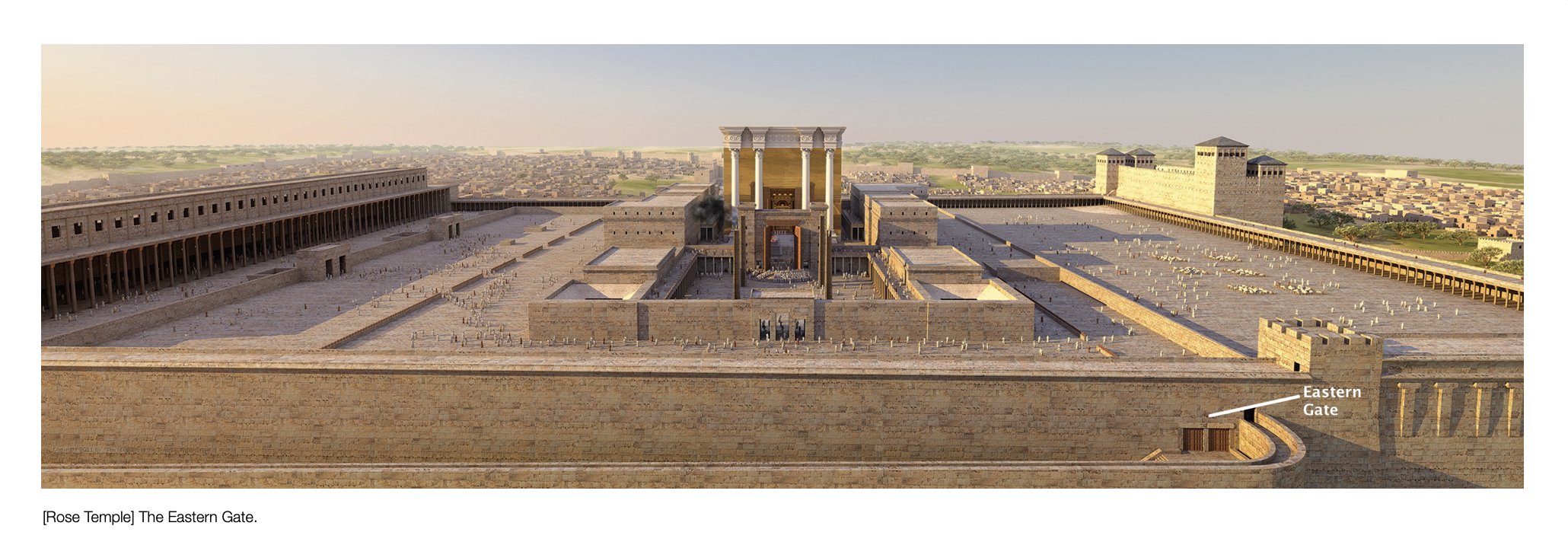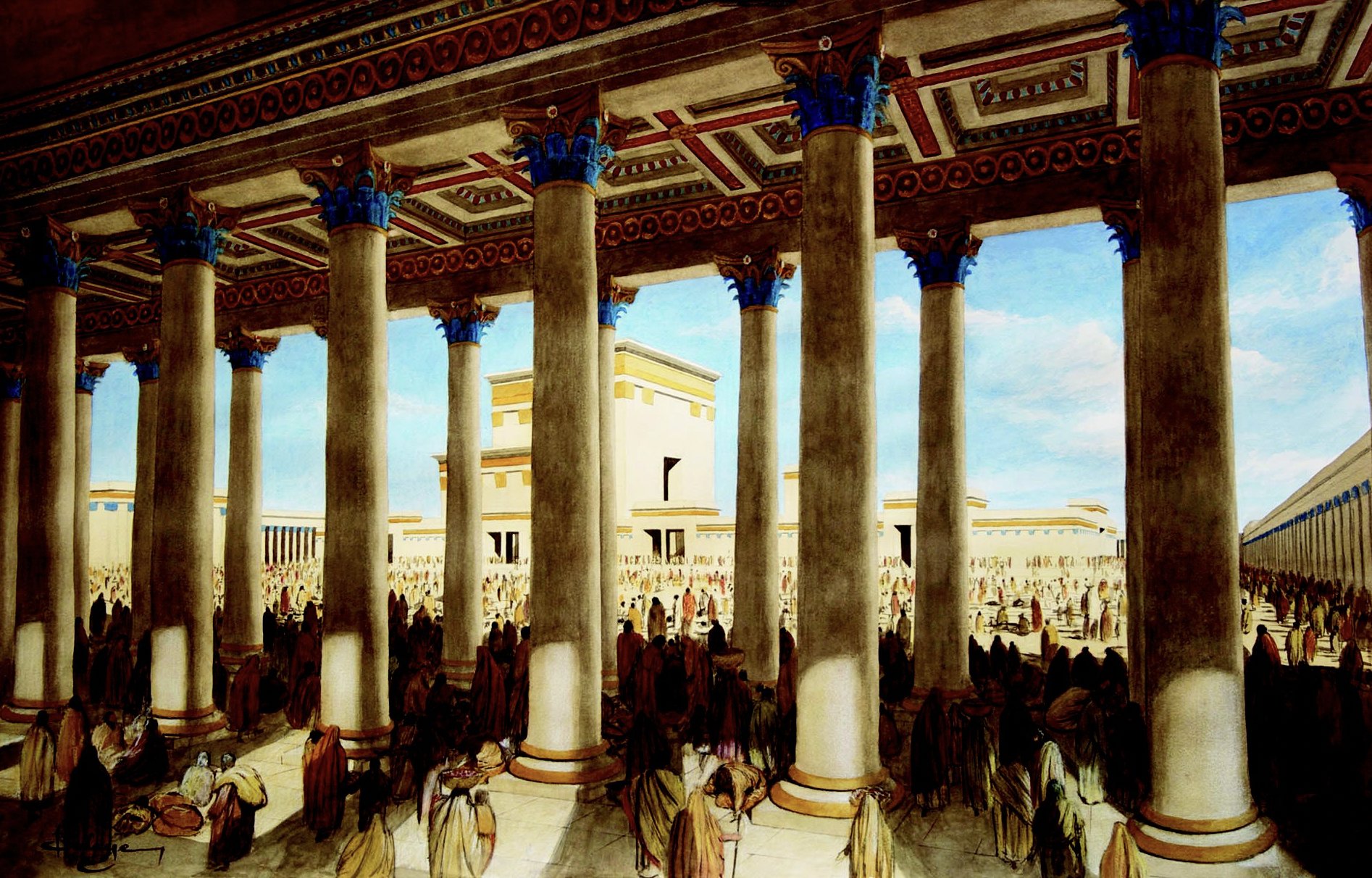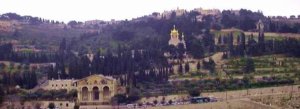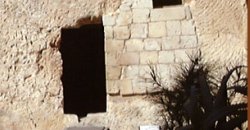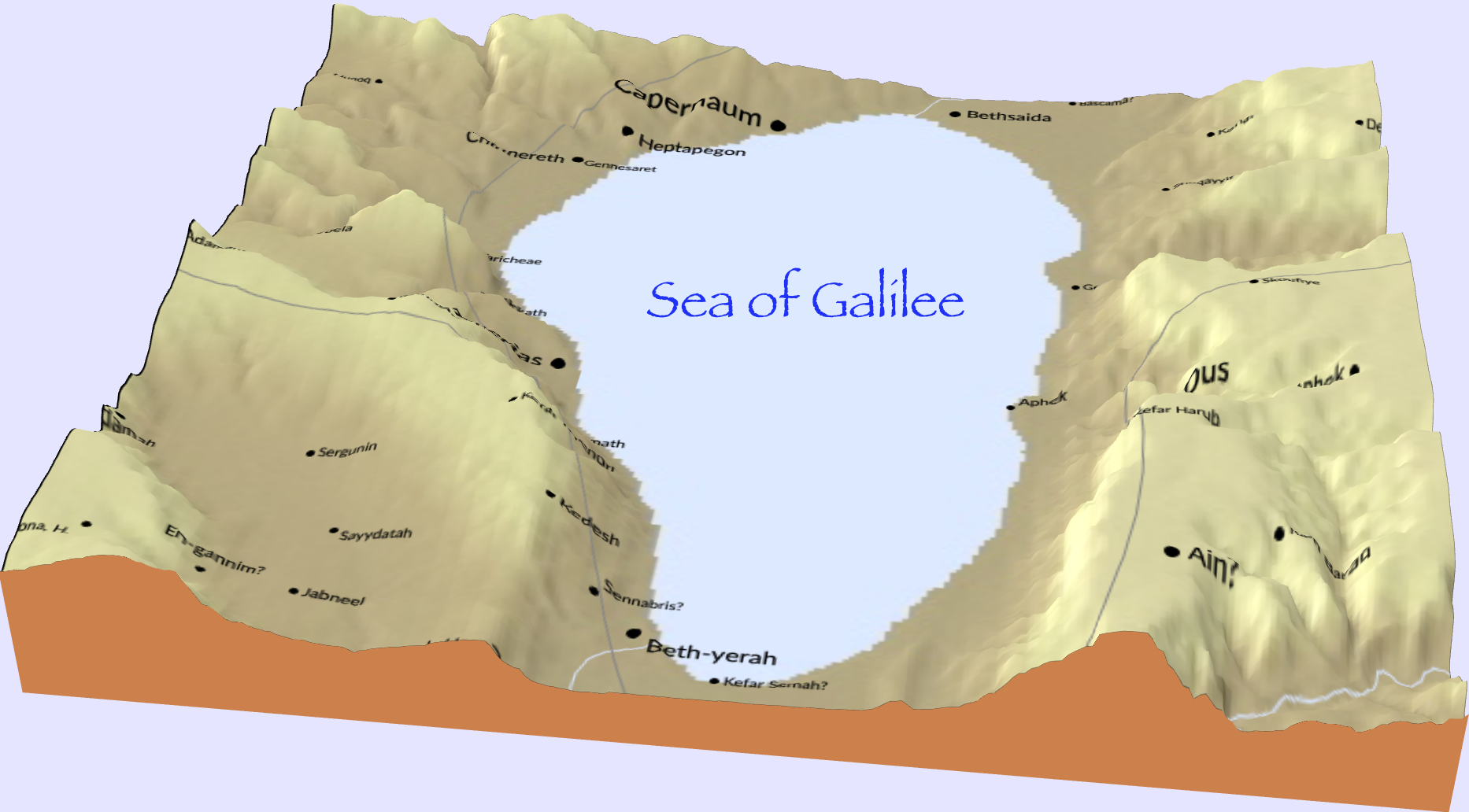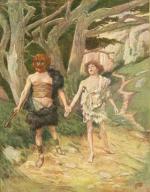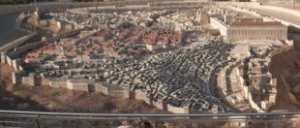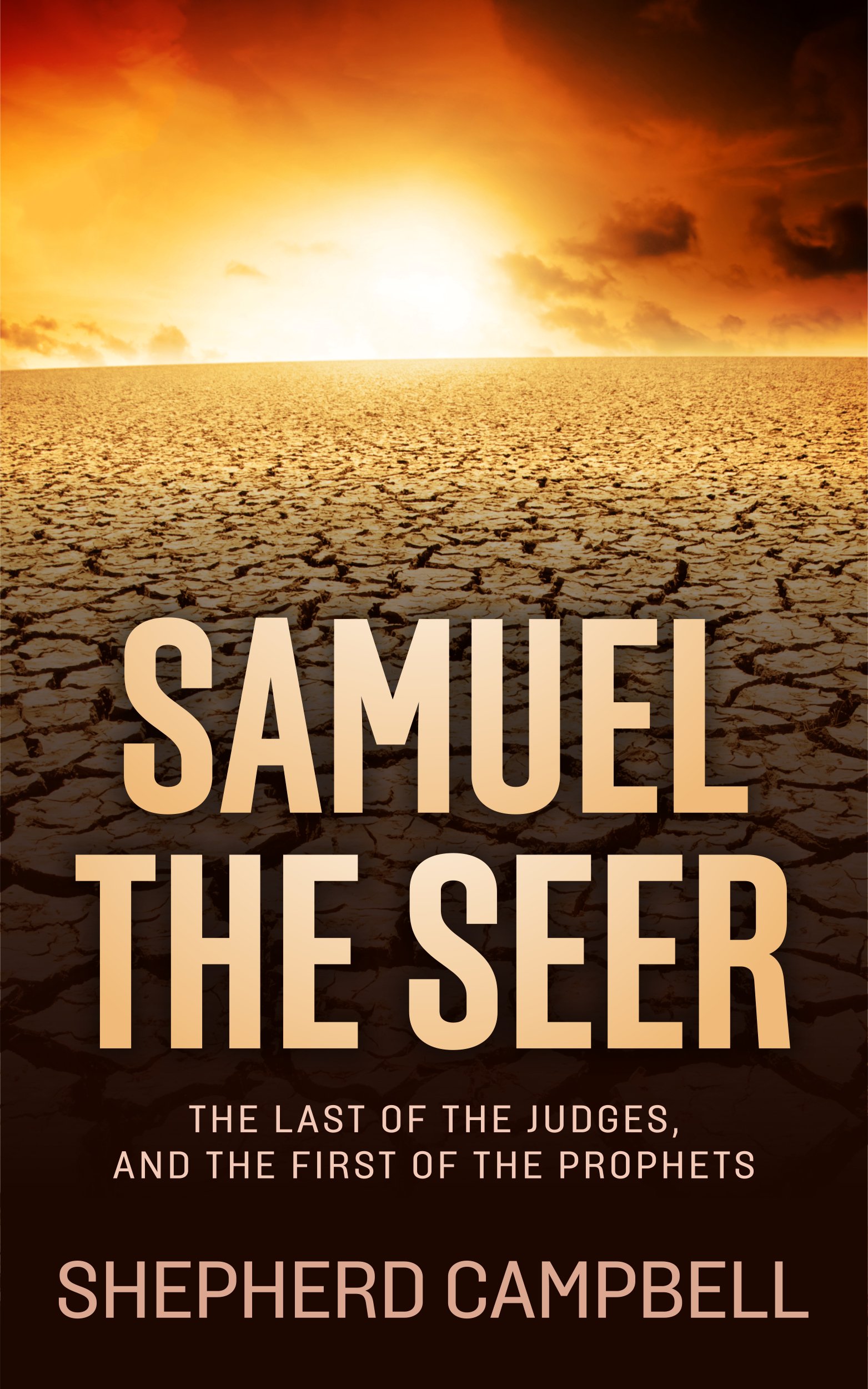- Biblical Maps
- Home Page
- History of Israel Blog
- Ancient Mesopotamia
- Map of Palestine
- Abraham
- Ancient Israel
- 12 Tribes of Israel
- Jerusalem
- The Book of Isaiah
- Palestine
- The Habiru
- Contact Us
- Bible Study Forums
- Media Page
- Visitors Sitemap
- Privacy Policy
- The History of the Old Testament
- In the Days of Noah
- The City of Jericho
VISIT OUR FACEBOOK PAGE!
Jesus in Jerusalem
Jesus in Jerusalem
Each of the Gospels give an account of Jesus throughout the course of His life and ministry. Each account differs in length and gives a unique portrayal of events surrounding Christ in Galilee and in the city of God. The Gospel of John gives the most detailed accounts concerning different appearances of Christ in Jerusalem. John also depicts Jesus' ministry in Jerusalem more than any other Gospel.
The number of times Jesus journeyed to Jerusalem and the total amount of time He spent there throughout His life is impossible to know for certain.
Despite the different accounts and details each Gospel portrays it is evident He spent time there and journeyed to Jerusalem for many of the Jewish feasts. Scripture makes it plain He taught in the Temple precincts, spreading His gospel to all who would listen. Jesus frequently appeared in Jerusalem during celebrations and feasts where throngs of people would have been present to hear His message. These times would have also been under heightened watch by both the Jewish and Roman authorities.
The book of John details the most accounts of Jesus in Jerusalem. In John He is depicted as attending 3 Passover Feasts, the most significant of the Jewish feasts, as well as the Feast of Booths and the Feast of the Dedication. This account places Jesus in Jerusalem at least five times just in the three year length of His ministry. He also made several appearances near Jerusalem, such as where John was baptizing, and the nearby suburbs of Bethany and Bethphage.
JESUS IN JERUSALEM - HISTORICAL CONTEXT
Jesus also would have visited Jerusalem on numerous occasions while growing up. The Bible records Jesus in Jerusalem as an infant. His parents, Mary and Joseph, had taken Him to the Temple in order to fulfill their obligation to present the child to God. Another instance is recorded where a twelve year old Jesus visits the Temple during Passover with his family, and likely a large group of extended relatives and friends. His parents realize Jesus is missing one day into the journey back, at which point a panicked couple hurried back to Jerusalem. They found Him three days later, sitting in the Temple talking and asking questions with the priests.
All Gospels are also consistent with the narrative of Jesus journeying near Jerusalem to be baptized Himself by John the Baptist. In the book Jerusalem by Simon Sebag Montefiore, he states Jesus' baptism took place around 28-29 AD, according to the opening chapters of Luke. Jesus was thirty years old when John baptized Him in the Jordan.
Though Jesus was not in Jerusalem proper, the Baptist was preaching near enough the city to draw out many citizens to hear his message and be baptized. The Bible informs us great multitudes flocked to John's location, to be discussed in more detail later. Temple priests and scribes flocked to hear his message, as well as many others from the surrounding villages. Jesus was likely just another face in the crowd at this point in time. The Baptist knew who He was, but Jesus had not yet began His public ministry. This baptism, in fact, signaled the beginning of Christ's ministry on earth. On a later occurrence of Jesus in Jerusalem, He withdrew to this area to escape the authorities.
The Passover occurred once a year, drawing tens of thousands of pilgrims to the Temple and Jerusalem. The Gospels picture Jesus in Jerusalem during each of the three Passovers of His three-year ministry, as well as journeying to it as a youth. The city of Jerusalem swelled to many times it's normal population during the Passover. Pilgrims from all over the globe would set out for the Passover. A comparable scene would be Mecca today during the great Islamic festivals which attract hundreds of thousands of Muslims.
JESUS IN JERUSALEM PAGE CONTENTS
Click to view what others are saying about Jesus Christ!
Click on a link to view that section of Jesus in Jerusalem.
Map of Jesus' Routes to Jerusalem
Map of Jerusalem During the time of Jesus
Model of the TempleThe Passover remembered God's deliverance of their forefathers from the throes of Pharaoh and slavery in Egypt. God's miraculous deliverance, led by Moses, included the death of every first-born male of Egypt's. He passed over the Hebrews, however, due to the blood marked on the door posts of each Israelite household. People journeyed from all over the ancient world to fulfill their Godly obligation to remember the Passover and keep it holy. Josephus stated at one particular feast one million people thronged to Jerusalem for the Passover celebration.
|
|
First century AD Jerusalem, specifically the years from 1 AD to 33 AD, witnessed a golden era of the ancient city. Herod the Great changed Jerusalem into one of the great cities of the ancient world. His architectural achievements included the Temple, a Roman-style theater, an extension of the city west of the Temple Mount, and a grandiose palace for himself away from the Jewish section of ancient Jerusalem. The Upper City was adorned with opulent houses for the rich. The High Priest, and other elites would have had their homes in the Upper city. It was the luxurious neighborhood of Herod and the Jerusalem ruling class and elite. |
|
Herod changed Jerusalem from a secluded mountain fortress into a Romanized metropolitan of architectural genius and wonder. At the same time his psychotic behavior, at one point murdering 45 of the 71 members of the Sanhedrin, cast a subdued fear over Jerusalem. The city had grown to cover over 400 acres. Population estimates place it between 20,000 to 50,000 people. Josephus estimated the circumference of the city was 33 furlongs, or 3 1/2 miles. By the time of Jesus the name Jerusalem not only included the city and its surrounding suburbs, towns and villages, but also came to represent a district of Judea. Herod's massive construction projects would have been taking place throughout the city, adding to the hustle and bustle of everyday life. Pilgrims, Jews, Romans, festivals, the Temple, and Jesus in Jerusalem would have created a very tense, exciting and charged atmosphere. |
THE TEMPLE MOUNT CAN BE SEEN CENTER-RIGHT. THE NARROW SLIVER OF LAND IMMEDIATELY SOUTH OF THE TEMPL & CURVING SOUTH ALONG THE RIDE IS THE CITY OF DAVID. UPPER JERUSALEM SITS ABOVE LOWER JERUSALEM, TO THE WEST OF THE TEMPLE. |
Herod upset many of his fellow Jews by the construction of such Roman buildings as the theater and hippodrome. He was a polarizing figure, yet maintained friendships in high places. Many of Herod's projects were dedicated to his Roman benefactors. He was accepted as a friend of Octavian, also known as the emperor Augustus, and a friend of Marc Antony as well. Herod was a master at playing both sides, hedging his bets, and jockeying himself into favorable positions. He exchanged political intrigues with the ever shrewd and deadly Cleopatra.
Herod built a massive platform, the first of its kind, upon which to extend the Temple. Platform ruins are visible today. Herod's Temple took eighty years of construction to complete from start to finish. Jesus in Jerusalem would have encountered this construction, and the noise and confusion that came with it. Many baths for ritual purification and small shops surrounded the Temple.
Some of these shops still have hitch posts for animals visible today amongst the ruins. Herod's Second Temple was fully completed not long after Jesus' death and resurrection.
Full completion, ironically,
came just years prior to the Roman destruction of this same Second
Temple and the burning and looting of Jerusalem in 70 AD. These were
turbulent times in Judah.
By the time of Jesus, Jerusalem was in it's fifteenth generation of Graeco-Roman influence (http://www.time.com/time/magazine/article/0,9171,999673-6,00.html). Jewish families gave Greek and Roman names to their children. Much of the city's architecture was in the Graeco-Roman style, thanks to Herod, including the Temple in Jerusalem. As Jesus taught in the Temple precincts, and the priests performed the holy rites and rituals within the Temple compound, between two and three thousand Roman troops would have looked on from the adjoining Antonia Fortress, another Herodian addition to Jerusalem. The Jewish religion was very peculiar to the Romans, who worshiped many gods. Indeed the two cultures, though similar in many ways, varied widely in the realm of religious thought and belief.
Caravans from Samaria, Syria, Egypt, Nabatea, Arabia and Persia were common sights within the city walls, especially during times of religious festivals and celebrations. The city burst out of its walls into the surrounding countryside. Steady streams of traffic likely ran in and out of Jerusalem's many gates. Jerusalem was a true ancient metropolis, incorporating all facets of society from many different cultures and influences. In the years spanning anywhere from 28 to 34 AD, the news of Jesus in Jerusalem would have electrified this ancient hilltop fortress.
THE GOSPEL OF MATTHEW
The book of Matthew depicts Jesus in Jerusalem only two times. Matthew, along with the other Gospels, speak of Jesus near Jerusalem being baptized by John the Baptist. The location of this site remains a topic of debate and controversy to this day. Some place it west of the Jordan, while others say it lay in "Bethany beyond the Jordan", meaning on the east side of the Jordan River. Regardless, the Baptist's location was at most one day's walk from Jerusalem, a short distance by ancient standards.
Matthew 3 state John was baptizing in the wilderness of Judea. Whatever the location, it was close enough to Jerusalem that in verse five Scripture states;
"Then Jerusalem was going out to him, and all Judea, and all the districts around the Jordan,"
Jesus appeared and was baptized by John the Baptist, who was the only one to recognize Jesus for who He was. As stated above, Jesus had not yet started to preach publicly, thus was likely an unknown. Scripture, though, is silent in regards to such specifics. The Spirit of God descended on Jesus in the form of a dove as He rose from the waters.
Matthew 3:17 records a "voice out of the heavens" was heard proclaiming Jesus God's son. Though the Bible gives no further detail, those present must have been confused as to the voice and the meaning. The exact reaction of those standing nearby is not recorded, though certainly an interesting thought.
The first actual appearance of Jesus in Jerusalem according to Matthew takes on a surprising nature. Immediately after being baptized, Jesus is depicted as heading out into the wilderness to be alone. Frequently the Gospels portray Jesus withdrawing by Himself, or a small number of select disciples. In this instance, Matthew 4:1 states:
"Then Jesus was led up by the Spirit into the wilderness to be tempted by the devil."
The map depicts Jesus' route to John the Baptist. Jews avoided traveling through Samaria on their way to Jerusalem from Galilee. They would thus cross the Jordan River twice during the journey, avoiding Samaria to the east. The Baptist's location, though uncertain, is depicted as being on the eastern side of the Jordan, just at the point Jesus would have crossed the second time on His voyage.
AT TIMES JESUS TRAVELED EAST OF THE JORDAN BEFORE RECROSSING AT JERICHO. OTHER TIMES JESUS TRAVELED THROUGH SAMARIA, THE MORE DIRECT ROUTE, YET THE JEWS LOOKED DOWN UPON SAMARIANS.
From this point of crossing, most would continue west to Jerusalem. Multiple routes led out of Jericho, with one leading to Jerusalem, and another into the wilderness. It is a theory that Jesus took the road leading to the northeast, into the Judean wilderness.
The devil appeared to Jesus in the wilderness, testing Him through a number of fleshly temptations and weaknesses. Matthew 4:5 relates one of these tests. "Then the devil took Him into the holy city; and he had Him stand on the pinnacle of Temple,"
From here the devil tempted Jesus to throw Himself from the top and have the angels rescue Him. Jesus responded with the classic verse;
"On the other hand it is written; 'YOU SHALL NOT PUT THE LORD YOUR GOD TO THE TEST."
This is a supernatural occurrence of Jesus in Jerusalem. Holman's Atlas states Herod's Temple rose to heights exceeding 180 feet in some places from bedrock to the top of certain towers. We do not know in what form He appeared, or if it was a physical or spiritual manifestation. One cannot presume to know anymore details about this occurrence than what is recorded in Scripture, thus it is best left alone.
Matthew's third and final mention of Jesus in Jerusalem is the Triumphal Entry into Jerusalem. Matthew 21-28 narrate Jesus' last week in Jerusalem leading up to His death and resurrection, as well as His resurrected appearances throughout Jerusalem. All four of the Gospels spend great detail on the last week of Jesus in Jerusalem. The Triumphal Entry of Jesus in Jerusalem as Messiah was followed by arrest, denial, trial, beating, crucifixion and death. The followers of Jesus dispersed, as His apostles are pictured fleeing to the Upper Room in fear of "the Jews".
THE GOSPEL OF MARK
The Gospel of Mark is similar in many ways to Matthew. Mark records two instances of Jesus in Jerusalem, with only one actually happening within the city walls. Mark also lends a great deal of detail to the last week of Jesus in Jerusalem. One significant difference, however, is that Mark depicts Jesus in Jerusalem dwelling among His disciples after His death. Whereas Matthew only mentioned two resurrected appearances, Mark puts Jesus in Jerusalem three times in resurrected form.
Mark 1:9 relates Jesus' baptism by John the Baptist much the same way as Matthew does. When Jesus rose from the water, a dove descended upon Him accompanied by a voice from Heaven. Jesus is led into the wilderness, as in Matthew, though much less detail is given as to the specific tests. After Jesus overcomes the devil, Mark states He proceeds to Galilee. Christ began His ministry outside of Jerusalem, and great detail is also given these accounts throughout the Gospels.
Jesus is depicted as journeying to Capernaum in Mark 1. This begins His ministry, and the book of Mark spends most of the first ten chapters in Galilee. Jesus in Jerusalem is not mentioned by Mark until chapter eleven. Mark 11-15 depict Jesus' last week in Jerusalem. Chapter sixteen speaks of His resurrected appearances.
CHRIST TURNED WATER INTO WINE AT A WEDDING IN CANA. ALONG THE BANKS OF THE SEA OF GALILEE HE CALLED HIS DISCIPLES. THE GREATEST SERMONS IN THE HISTORY OF MANKIND WERE TAUGHT ON THE HILLTOPS OF GALILEE, AND IN THE WATERS OF THE SEA OF GALILEE.
It becomes evident that two distinct ministries took place with Jesus. One ministry took place around the Sea of Galilee. Jesus spent valuable time on the road with His disciples between villages and towns in Galilee. These occasions allowed one-on-one time with the apostles. His other ministry was in the hustle and bustle of the great city of God. Jerusalem was an altogether different atmosphere than the fishing villages of the Galilee.
When the disciples were with Jesus in Jerusalem much time was spent around the Temple compound and in the suburbs, where He stayed with such friends like Martha, Mary and Lazarus. In the city, Jesus reached more diverse crowds, while at the same time drawing the ire and eventual wrath of the authorities. Regardless of in the city or the countryside, Jesus Christ drew a crowd during His public ministry.
Mark's second instance of Jesus in Jerusalem takes place in Mark 11:1, the Triumphal Entry of Jesus into Jerusalem. Jesus had traveled to Jerusalem through Jericho in chapter ten.
Jesus would have approached Jerusalem from the east, in the direction of Bethphage and Bethany. Bethany was a suburb of Jerusalem about 1.8 miles to the east. The village was on the slopes of the Mount of Olives, thus Jesus would have journeyed over the Mount of Olives each day. Lazarus lived here, and it was here Jesus stayed during His last week.
Jesus had sent two of His disciples ahead into Jerusalem. They were instructed in verse two to look for a colt and bring it to Him. The disciples found things as Jesus had predicted, and brought the colt out to Him. Matthew 11:7-9 details the Triumphal Entry of Jesus in Jerusalem.
"And they brought the colt to Jesus and put their garments on it; and He sat upon it. And many spread their garments in the road, and others spread leafy branches which they had cut from the fields. And those who went before, and those who followed after, were crying out, 'Hosanna! Blessed is he who comes in the name of the Lord; "
This recorded instance of Jesus in Jerusalem, however, is brief. For immediately upon entering the city, verse eleven states He entered the Temple, "and after looking all around, He departed for Bethany". Jesus seems to be surveying the battleground in this instance. He likely took notice of the moneylenders stationed all around. Commerce and trade filled the Temple. Perhaps Jesus began to formulate His attack on the moneylenders which would take place the next day. Perhaps He just wanted to look upon His Father's house.
The remainder of Mark is spent relating the last week of Jesus. Mark 16, though, relates three specific appearances of Jesus in Jerusalem. These are significant because they take place after His death. Mark lists three appearances of the resurrected Jesus in Jerusalem. The first of these occurs in Mark 16:9.
"Now after He had risen early on the first day of the week, He first appeared to Mary Magdalene, from whom He had cast out seven demons."
Mary, of course, ran to tell the disciples who refused to believe her. Immediately preceding this verse is yet another appearance of Jesus in Jerusalem. This appearance takes place on an unidentified road. The timing in Scripture implies one happening right after the other. In verse nine it is to Mary Jesus appears, and three verses later in Mark 16:12-13 He appears again.
"And after that, He appeared in a different form to two of them while they were walking along on their way to the country. And they went away and reported it to the others, but they did not believe them either."
The third resurrected appearance of Jesus in Jerusalem takes place just two verses later. Mark 16:14 records an interesting encounter between Jesus and His disciples. This incident is presumably one of the appearances of Jesus in the Upper Room. The Gospels of Luke and John also mention at least one appearance of Jesus in the Upper Room. John lends more insight than any, as it tends to focus more on Jesus' ministry in Jerusalem.
With Jesus in Jerusalem the authorities were on high alert, and the Roman occupiers glanced nervously at the crowds. What John tells us sheds valuable insight into the political situation in first century Jerusalem immediately following the death of Jesus. John informs us the disciples had gathered in a room;
"when the doors were shut...for fear of the Jews".
The atmosphere in the twenty-four hours following the death of Jesus in Jerusalem was one of intense anxiety for His followers. They feared their for lives as well. If their leader could be put to death by the authorities, then they were surely in danger as well. They had locked themselves in an Upper Room. Though seemingly some of them moved about, as Thomas was absent during one appearance, and Jesus appeared to two on a country road, they did so discreetly and likely only when absolutely necessary.
The rest of the time they were shut in, out of view, underground. Such was the mood of the disciples leading up to Mark 16:14.
"And afterward He appeared to the eleven themselves as they were reclining at the table, and he reproached them for their unbelief and hardness of heart, because they had not believed those who had seen Him after He had risen." Though this passage in Mark does not give a time as to when it occurred, it would seem likely it was one of the first appearances of the resurrected Jesus in Jerusalem. The reason being it mentions only eleven being present, meaning Thomas was the disciple missing as mentioned in other Gospels. However, the next appearance of Jesus occurs with His ascension.
The chronology in Mark seems to indicate the ascension took place after Jesus' first appearance in the Upper Room. This, however, should not be assumed to indicate such, as specifics are not mentioned in Mark. By combining the other accounts, one can formulate more of a detailed account of the resurrected appearances of Jesus in Jerusalem and Galilee leading up to His glorious ascension.
Mark 16:19 gives a brief account of Jesus' ascension.
"So then, when the Lord Jesus had spoken to them, He was received up into heaven and sat down at the right hand of God."
This was all Mark mentioned about the ascension. Mark places Jesus at the right hand of God, where He sits today in anticipation of the eventual judgement of mankind.
THE GOSPEL OF LUKE
Luke describes the earliest account of Jesus in Jerusalem. Luke 2:21-22 states Jesus was taken to Jerusalem by Mary and Joseph when He was eight days old as the Law prescribed for all newborns. He was to be dedicated at the Temple as well as circumcised.
"And when eight days were completed before His circumcision, His name was then called Jesus, the name given by the angel before He was conceived in the womb. And when the days of their purification according to the law of Moses were completed, they brought Him up to Jerusalem to present Him to the Lord."
Some scholars indicate this verse seems to imply Jesus was closer to forty days old, as this would have been the time necessary for Mary's purification after the birth of Jesus. Regardless, He was an infant, and fulfilling His obligation to the law. Born under the law, He perfectly fulfilled all of the law. Even this first appearance of Jesus in Jerusalem as an infant attracted some attention.
Verses twenty-five through thirty-eight tell the story of two righteous individuals that see Jesus the baby, and immediately recognize Him for who He is. One was an old man named Simeon and the other a prophetess, Anna the daughter of Phanuel of the tribe of Asher. Simeon, said to have been a righteous and devout man, praised God for allowing him to see "Thy salvation" in the infant Jesus.
One can only imagine the thoughts of Mary and Joseph as Simon looked at them and said, as stated in verses 34-35.
"Behold this Child is appointed for the fall and rise of many in Israel, and for a sign to be opposed - and a sword will pierce even your own soul - to the end that thoughts from many hearts may be revealed,"
Verse thirty-six also speaks of a prophetess named Anna who recognized the baby Jesus. Scripture records Anna continued speaking of Him "to all those who were looking for the redemption of Jerusalem". Thus from the very beginning Jesus in Jerusalem drew notice as a special occasion.
The second appearance in Luke of Jesus in Jerusalem occurs in Luke 2:41-52. In this narrative Jesus is twelve years old and again visiting Jerusalem with His parents for a Passover feast. Jesus and His family would have traveled with a large party of extended relatives and friends from Nazareth. Such pilgrimage groups would join with others along the way, for in numbers there was safety. Travel during the first century AD could prove dangerous.
The distance north to south from Jerusalem to Nazareth was approximately 70 miles. This direct route, however, led through Samaria. Samaritans were viewed as unclean by Jews, and thus travel through their land was avoided. This meant the journey would have covered approximately 100 miles, as this route took them east of the Jordan River. This would have been a journey of approximately ten days, at the average of eleven miles per day.
"And His parents used to go to Jerusalem every year at the Feast of the Passover. And when He became twelve, they went up there according to the custom of the Feast;"
This was likely not the second time Jesus had been in Jerusalem. Scripture implies the boy Jesus had been prior to this trip, attending the previous Passovers with His parents. Thus Luke's second instance of Jesus in Jerusalem does not necessarily indicate this was only Jesus' second visit to the city. Luke tells us the family spent one week in Jerusalem this visit, as was custom for the Festival of Unleavened Bread. They likely stayed in the suburbs of the city, where He would spend His last week on earth with friends approximately twenty years later.
No details are given concerning the week they spent in Jerusalem. The narrative picks up in verse 43 where Mary and Joseph are said to have departed the city after the Passover, unaware they had left Jesus in Jerusalem. This seems much more careless in our current context than it would have been during first century Jerusalem.
Mary and Joseph's traveling party included many relatives and close family friends. Jesus would have naturally thought to have been safe with any number of people in their traveling party. Thus, as the party departed Jerusalem all would have been assumed to be present. Scripture relates such, saying Mary and Joseph "supposed Him to be in the caravan".
After a day's journey Mary and Joseph realized they had left Jesus in Jerusalem. A panicked mother and father made hastened back to Jerusalem, and spent three days looking for Jesus in the city! One can only imagine the feeling Mary and Joseph must have had upon seeing Jesus sitting in the Temple. Scripture depicts an angry, or at least perturbed, Mary in verse forty-eight.
"Son, why have treated us this way?"
Jesus' response indicates He had a distinct awareness of who He was at the age of twelve.
"Why is it that you were looking for Me? Did you not know that I had to be in My Father's house?"
The young Jesus was challenging the minds of the aged priests at twelve years old. He was "both listening to them, and asking them questions". What a fascinating picture of a young Jesus, probing the minds of the "experts" on the law, forming His beliefs and thoughts, communing with His Father. The extent of Jesus' awareness of who He was is, of course, speculation as Scripture is silent about such matters. It is, however, a thought provoking subject, and one briefly touched on in Scripture. This instance of Jesus in Jerusalem was only a foreshadowing of what would come. Jesus would again sit in the Temple and confront these same priests.
Luke's next appearance of Jesus in Jerusalem takes place some years later, as Jesus makes His way to Jerusalem for the final time. Luke 19 opens with Jesus making His way into Jericho. It would seem by this account that Jesus had traveled south from Galilee, down the eastern side of the Jordan River and had crossed at Jericho on His way to Jerusalem.
It was on this journey from Jericho to Jerusalem that Jesus stopped and told the crowd the parable of the Money Lenders, found in Luke 19:11-27. The telling of this parable took place near Jerusalem. After finishing the parable, Jesus continued on His way west from Jericho towards Zion. Coming from Jericho He would have entered the suburb villages of Bethphage and Bethany, on the slopes of the Mount of Olives.
Luke tells us from Bethany He sent two disciples ahead to secure the colt He would enter Jerusalem on. Thus Luke begins his account of the Triumphal Entry and the last week of Jesus in Jerusalem. During this week He stayed in the suburb of Bethany with His friends Lazarus, Martha and Mary. Luke continues to deal with the last week of Jesus through chapter 23. Luke 24 deals with the resurrected Jesus in Jerusalem.
Luke describes three total appearances of the resurrected Jesus in Jerusalem. Unlike the previous two Gospels, Luke does not describe the appearance of Jesus to Mary in the early morning hours following His resurrection. The first appearance of Jesus in Jerusalem as recorded by Luke occurs on the road to Emmaus. Emmaus was seven miles to the west of Jerusalem. Luke 9:13-15 describes the appearance.
"And behold two of them were going that very day to a village name Emmaus, which was about seven miles from Jerusalem...And it came about that while they were conversing and discussing, Jesus Himself approached, and began traveling with them. But their eyes were prevented from recognizing Him."
One of these men was named Cleopas. We do not know how long Jesus
stayed with these men, but He traveled all the way to Emmaus with them,
explaining the Scriptures to them as they went, according to verse
twenty-seven. Jesus even sat down to eat with the men, yet when He broke
the bread and gave it to them, Scripture relates;
"their eyes were opened and they recognized Him; and He vanished from their sight."
So shocked and surprised were these men that they "arose that very hour and returned to Jerusalem". How electrifying these moments must have been! The resurrected Jesus in Jerusalem empowered an otherwise defeated group of small followers. Luke next portrays Jesus appearing to His disciples as they were gathered together, presumably in the Upper Room.
Though the chronology of the resurrected Jesus in Jerusalem is hard to determine, it is clear things were happening quickly. Luke 24:36 speak of another appearance of the resurrected Jesus.
"And while they were telling these things, He Himself stood in their midst."
Though the Bible is silent as to where this appearance takes place, when taken in context with the other Gospel accounts it seems plausible to suggest this took place in the Upper Room. If this was the Upper Room, then the disciples were surely in a state of high alert and anxiety. Verse thirty-six makes it clear the travelers on the road to Emmaus had returned and were "telling these things" to the remaining disciples. One common theme throughout is the disbelief that accompanied Christ's disciples upon first learning of His resurrection.
Luke tells us when Jesus appeared to them, "they were startled and frightened and thought that they were seeing a spirit". Their world had been turned upside down. The one they thought was their king had died unceremoniously on a wooden Roman-made cross. Things were not as they had foreseen, and they certainly did not expect to see Jesus standing in front of them.
"Why are you troubled, and why do doubts arise in your hearts?"
The questions seem natural for Jesus to ask, except for the fact He had just risen from the dead. As He had taught them about what was to come, Scripture indicates they did not fully grasp what He was telling them. Now His questions were invitations to a new level of faith.
"See My hands and My feet, that it is I Myself, touch Me and see, for a spirit does not have flesh and bones as you see that I have."
Then, as if this were not enough, the disciples "gave him a piece of broiled fish, and He took it and ate it before them". This scene is reminiscent of when God visited Abraham with two of His servants in Genesis 18. God and His mysterious company sat and ate with Abraham just as Jesus ate with His disciples. This act symbolized His complete victory over death.
Luke's narrative again moves quickly from one episode to another. In verse fifty Jesus leads "them out as far as Bethany", where He blesses them. Luke then simply states in verse fifty-one;
"And it came about that while He was blessing them, He parted from them."
The transformation of His disciples is seen in the last two verses of Luke's account. John tells us they had locked themselves up in the Upper Room, afraid for their lives. They had gone underground. Now, according to Luke, after Christ's Ascension they "returned to Jerusalem with great joy, and were continually in the temple, praising God". His disciples had been empowered by the resurrected appearances of Jesus in Jerusalem.
THE GOSPEL OF JOHN
Of the four Gospels none give a more detailed account of Jesus in Jerusalem than John. Whereas Matthew, Mark and Luke gave a great deal of focus to Jesus in Galilee, the Gospel of John focuses on His Jerusalem ministry. John lists Jesus in Jerusalem at least on six occasions. He records three Passover Feasts (Jn. 2:13; 6:4; 11:55), one Feast of Booths, or Tabernacles (Jn. 7:2), an unnamed feast (Jn. 5:1), and a Festival of Dedication, or Hanukkah (Jn. 10:22).
The book of John opens up with Jesus venturing to see John the Baptist near Jerusalem. One must keep in mind this encounter took place before Jesus had began His public ministry. The Bible is mysteriously silent as to what took place in Jesus' life prior to His public ministry in the Gospels. Thus the words of John the Baptist in John 1:29 would have seemed strange to the onlookers, as Jesus was likely just another face in the crowd at this time.
"The next day he saw Jesus coming to him, and said, 'Behold the Lamb of God who takes away the sin of the world."
With this act Jesus began His ministry on earth as recorded by the Gospels and other non-biblical accounts. Matthew tells us that from here Spirit-led Jesus journeys into the wilderness to square off with Satan. Matthew reports Satan and Jesus in Jerusalem, standing on the pinnacle of the Temple, the devil attempting to thwart Jesus' divinely appointed mission. John, however, does not delve into the temptation of Jesus.
Rather, John quickly moves to depict Jesus in Jerusalem again, this time for the Passover in John 2:13. The time frame involved with this appearance has drawn some debate.
"And the Passover of the Jews was at hand, and Jesus went up to Jerusalem."
The Passover was accompanied with the festival of the Unleavened Bread. Leviticus 23:5 describes the two.
"In the first month, on the fourteenth day of the month between the two evenings is the lord's Passover. And on the fifteenth day of the same month is the feast of unleavened bread unto the lord; seven days ye shall eat unleavened bread. In the first day ye shall have a holy convocation; ye shall do no manner of servile work. And ye shall bring an offering made by fire unto the lord seven days; in the seventh day is a holy convocation; ye shall do no manner of servile work."
The Passover celebrated the Exodus out of Egypt. Leviticus states the Israelites were to eat unleavened bread only during the duration of the Passover, thus the festival of Unleavened Bread accompanies the seven day Passover. Jesus in Jerusalem during the Passover would have included a seven day stay in the overcrowded city. Jerusalem swelled to many times its size during these special occasions. Many people were forced to stay in the surrounding suburbs and countryside. Jesus had some friends in Bethany thus He often stayed with them. Lazarus, Martha and Mary housed Him during the week leading up to His crucifixion and resurrection.
The debate is concerned with what happens next. Jesus marches
into the Temple where much trade and commerce was taking place.
Sacrificial animals were sold and traded for, as well as moneylenders
that exchanged whatever currency was given them for the Temple coins, of
course at different rates for their profit. John 2:15 recounts Jesus' actions.
"And He made a scourge of cords, and drove them all out of the temple, with the sheep and oxen; and He poured out the coins of the money changers and overturned their tables."
Each of the other three Gospels depict this happening during the last week of Jesus in Jerusalem. John, however, places it at the very beginning of His ministry. This may or may not be a contradiction, and shouldn't be used as evidence of discrepancies in the Gospels. The reason for this is simple. Jesus may have done a similar thing earlier, recorded in the tradition that John accounts for. Is it impossible He could have done it twice over the course of three years?
Of course this cannot be proven one way or the other either, and should not be taken as absolute truth. Yet, it is quite possible to conceive Jesus Christ could have cleared the Temple twice over the course of three separate Passover feasts in three years. Such would seem to be the case when the Gospel of John is taken into account with the other three Gospels.
From this point, the second appearance of Jesus in Jerusalem according to John comes to an end, for in 3:22 Jesus and the disciples are coming "into the land of Judea", the implication being they had left earlier from Jerusalem in the previous chapter. It becomes clear from tracing the movements of Jesus in the Gospels that He was constantly on the move. Possibly numerous times He traveled by Jerusalem without stopping. He had an itinerary only He knew as He and His disciples moved from one village to another, one side of the Jordan to the other, and one end of Canaan to another.
John's third account of Jesus in Jerusalem takes place in John 5:1-9. This feast remains unnamed throughout the narrative. Some versions indicate by footnote this feast is likely another Passover, though John does not specifically name it.
"After these things there was a feast of the Jews, and Jesus went up to Jerusalem."
Verse two even gives an exact location of Jesus in Jerusalem. John describes Jesus as being at the Bethesda Pool, near the Sheep Gate leading into the Temple from the north. Pool lined the different gates leading to the Temple. Ritual purification was essential to Temple worship, thus pools were present throughout ancient Jerusalem. The Bethesda Pool is located on the northern side of the Temple Mount. It's ruins are evident today. The Antonia Fortress prominently stood nearby.
People would have stopped to bathe and cleanse themselves before entering the Temple precincts through the Sheep Gate. Thus, large crowds typically gathered at the pools, especially during festivals and feasts. The New Testament speaks of a tradition first century Jews associated with the Bethesda Pool. It was believed that at certain times of the year "an angel of the Lord went down" and stirred the waters in the pool.
Scripture relates that after the waters had been stirred the first one to step into the pool would be healed from whatever affliction they suffered. John describes a man lying near the water on a pallet. This man had suffered from an unnamed ailment for 38 years, and had failed to enter the waters first on occasions the angel stirred up the pool. It was people such as this one that Jesus was drawn to.
Scripture seems to imply Jesus spotted the man immediately, knowing he had suffered for a long time in his present condition. Jesus asked the man if he wished to be cured, to which the man answered he had no help to put him in the waters when they stirred, thus he continued to suffer. Verses eight and nine record the words of Jesus.
"Jesus said to him, 'Arise, take up your pallet and walk."
There are certain things and details the Bible leaves out that would make for intriguing reading. Such details are often those associated with the reactions of people fortunate enough to witness such miracles by Jesus. The sick man was likely well-known by frequenters of the pool. They knew of his condition, had perhaps grown accustomed to seeing him there day after day. To see him all of a sudden jump up and start running around would have been shocking.
What is especially insightful in John's account of this is the reaction of "the Jews" in verse ten. They actually accuse the man of carrying his pallet, because it was the Sabbath and such was not allowed. They do not acknowledge the miracle given the man, only his "violation" of the law! Jesus later sees the man in the Temple and encourages him to "sin no more". The Jewish establishment, however, became upset over Jesus healing people on the Sabbath.
After this feast, Jesus departs Jerusalem and returns to Galilee (Jn. 6:1). John next places Jesus in Jerusalem (John 7) attending another feast, The Feast of Booths. Leviticus 23:41-44 describe the purpose and function of the Feast of Booths.
" 'You shall thus celebrate it as a feast to the Lord for seven days in the year. It shall be a perpetual statute throughout your generations; you shall celebrate it in the seventh month. You shall live in booths for seven days; all the native-born in Israel shall live in booths, so that your generations may know that I had the sons of Israel live in booths when I brought them out from the land of Egypt. I am the Lord your God.' So Moses declared to the sons of Israel the appointed times of the Lord."
This was the defining moment of Hebrew history. God interacted on behalf of the enslaved ancient Hebrews like He had with no other nation on earth before, and perhaps since. As such, He instructed celebrations as reminders of what He did for His people, and what He will do in the future. God has never stopped working since those ancient days. Scholars and historians, of course, write the narrative off as mere myth. No proof exists, nothing from the archaeological evidence, and so on and so forth.
John also sheds an important light on Jesus in verse three. Scripture mentions His brothers, thus shedding some light on Jesus' childhood. He grew up with siblings, multiple siblings. Interestingly, the tone of His brothers in this verse is one of ridicule.
"His brothers therefore said to Him, 'Depart from here, and go into Judea, that Your disciples also may behold Your works which You are doing."
They dared Jesus to venture to Jerusalem, where they knew the authorities were seeking Him. Jesus declines their invitation to travel to Jerusalem for the feast. However, John 7:10 reveals He went to Jerusalem anyway, "not publicly, as it were, but in secret."
Scripture informs us the Jews were looking for Jesus in Jerusalem. They likely had stationed lookouts at each of the gates leading into the city, and hid spies throughout the crowds. One must remember there would have been plenty of pilgrims and traffic coming into the city for the Feast of Booths. Jerusalem was a lively and vibrant city around these national celebrations. John also recounts the people were divided over Jesus.
Some claimed He was a good man, others that He led people astray. John lends fascinating detail into the situation in Jerusalem. The people were talking of Him openly, yet in hushed tones, "for fear of the Jews". This is likely in the second year of Jesus' ministry, thus He was by now well-known and already at odds with the Jewish authorities. Things were picking up and tensions were escalating over this commoner from Nazareth. He performed miracles and debated the scholarly authorities with skillful and precise arguments. Jesus in Jerusalem would not go unnoticed long.
"But when it was now the midst of the feast Jesus went up into the temple, and began to teach. The Jews therefore were marveling, saying, 'How has this man become learned, having never been educated?"
John lends beautiful details in this account of Jesus in Jerusalem - the ridiculing brothers, the split crowd, the paranoid Jews, the amazed priests and scholars. The scene has personality, narrative and drama. The length of Jesus' stay this time is not clear. Scripture indicates He stayed at least two days. The likely duration would be seven days, as the Feast of Booths was a seven day celebration.
On the last day of the feast, which Scripture relates was "the great day of the feast", Jesus stood up in the Temple and cried in verse 32;
"If any man is thirsty, let him come to Me and drink. He who believes in Me, as the Scripture said, 'From his innermost being shall flow rivers of living water.'"
This episode of Jesus in Jerusalem included Him forgiving the adulterous woman in John 8,
Him teaching in the Temple treasury, and Jesus fleeing the Temple as
the authorities picked up stones to stone Him with. As Jesus fled the
Temple, He and His disciples passed a blind man on the side of the road.
John 9 describes Jesus making clay with His spit and restoring the blind man's vision.
The time frame of Jesus in Jerusalem for this feast is a bit uncertain, however. In the next chapter (Jn. 10), Jesus is said to have traveled to Jerusalem for the Feast of the Dedication. This feast is also know as the Festival of Lights, or Hannukah. The Old Testament does not give detail concerning this Feast because it's establishment occurred during the Intertestamental Period, or the time period stretching from the last of the Old Testament to the beginning of the New Testament signaled by the birth of Christ.
It celebrates the Maccabean revolt, miraculous victory over Antiochus Epiphanes, and the re-dedication of the Temple. Epiphanes had persecuted Jerusalem ca. 168 B.C. He had dared enter the Holy of Holies in a foreshadowing of yet another abomination of desolation to occur in the last days. In 165 B.C. Judas Maccabeus instituted this festival after their successful rebellion. John also tells us this feast took place in winter.
John 10:22 illustrates Jesus in Jerusalem once again at the Temple. He was drawn to His Father's House for good reason. He preached throughout the Temple, in it's courtyards, in the treasury, and now John depicts Jesus in the portico of Solomon. Peter would later give a sermon in this spot in Acts 3. Jesus was once again being quizzed by the Pharisees, scribes and teachers of the Law.
Though cloaked in innocence their inquisitions were malicious in intent. With Jesus in Jerusalem they sought to entrap Him by their questions. They pursued proof He thought He was God, thus anytime He would declare something similar to that sentiment they would seek to stone Him, seize Him, beat Him, etc. etc. They accused Him of blasphemy by claiming to be the son of God. Thus, in verse thirty-eight when Jesus says "the Father is in Me, and I in the Father", the Jews become outraged and seek to seize Him.
However, as He was prone to do, Jesus eluded their attempts and fled the city. Without Jesus in Jerusalem the Pharisees and company were free to carry on their excesses without accusation. The Jewish royalty and elite were worldly in their pursuit of political gain and fleshly desires. The Herods were excessively wicked and murderous, often killing their own family. Jesus attacked the lifestyles of the establishment, often rousing the crowd of onlookers with His miracles and sermons. On top of the religious atmosphere, the occupying Romans always kept a close eye on Jerusalem, especially during the festivals. Any sort of public agitation was promptly taken care of. Roman force was always quick to be dispatched.
John relates in chapter eleven that Jesus fled "beyond the Jordan" to the place John the Baptist preached. This area was not very far from Jerusalem, as Jericho lie thirteen miles east. John 11 is the narrative concerning the death and resurrection of Lazarus. Shortly after these events, Jesus was informed of Lazarus' death. As discussed above, Lazarus lived with Martha and Mary in the village of Bethany. Bethany was less than two miles from Jerusalem.
Jesus, being nearby, was quickly summoned to Lazarus' house. He chose to remain put for two days before departing, however. By the time Jesus arrived Lazarus had been dead four days. Scripture informs that many Jews from Jerusalem had ventured to Mary and Martha's house due to Bethany's close proximity. Consequently, when Jesus raised Lazarus from the dead news quickly spread into Jerusalem of the miracle.
The ministry of Jesus in Jerusalem had reached out to all the surrounding countryside, towns and villages. Indeed, Christ was known throughout all of the land, from Galilee in the north, to the deserts south of Jerusalem, from the Mediterranean to east of the Jordan River, everybody knew of the lowly carpenter from Nazareth. Scripture makes it plain some believed and others did not. Those that did not reported His raising of Lazarus from the dead to the Pharisees. It was this miracle that sealed His death sentence, for in John 11:53 the Jewish authorities reached a consensus.
"So from that day on they planned together to kill Him."
Things escalate quickly from this point on in the Gospel of John. John 12 begins the last week of Jesus in Jerusalem, where He is attending His third and last Passover in John. Scripture reveals Jesus ventured first to Bethany, where he would stay with His friends Lazarus, Martha and Mary. It was this visit which Mary anointed Jesus' feet with perfume, much to the disgust of Judas Iscariot in verse four. The remaining chapters of John are dedicated to the days leading up to Christ's death and resurrection.
THE LAST WEEK OF JESUS IN JERUSALEM
Of the New Testament records of Jesus in Jerusalem, the most detailed are those regarding His last week in Jerusalem, the city of God. When Judas Iscariot and the Jewish authorities of the day arrested Jesus and sentenced Him to death, little did they know their actions would define an epoch and shape the world's largest religions. Each of the Gospels record the events in various details. A large segment of each Gospel is dedicated to the last week of Jesus in Jerusalem, and rightly so as it gave birth to Christianity.
SATURDAY NIGHT
The journey from Nazareth to Jerusalem was about 70 miles. Bethany was less than two miles from Jerusalem. Jesus arrives in Bethany, where he is staying at the house of Lazarus, whom he raised from the dead, and Martha and Mary (Jn 12:1). Martha serves them a dinner in Jesus’ honor and Mary anoints Jesus with costly perfume, foretelling the death and burial of Jesus. Judas Iscariot rebukes her for wasting such expensive perfume instead of selling it and giving it to the poor. John implies Judas' true motives in verse six, relating that it was Judas who possessed the money box and was guilty of taking from it.
Jesus tells Judas to leave her alone, saying; “You will always have the poor among you, but you will not always have me.” Others find out Jesus is staying at the house, and a large crowd gathers to see Him and Lazarus. The chief priests make plans to kill not only Jesus, but Lazarus as well. Lazarus had been proclaiming the name of Christ with fervor. Scripture tells that many believed in Jesus on account of Lazarus' efforts, thus the authorities debated getting rid of him as well.
SUNDAY – The Triumphant Entry
Jesus leaves from Bethany on a donkey for the nearly two mile journey into Jerusalem. John records a great multitude gathered on the street leading into Jerusalem from Bethany. As He descended down the slopes of the Mount of Olives, the crowd cried "Hosanna”, and followed Jesus into Jerusalem. It was on this approach that Jesus beheld Jerusalem lying below him and “wept over it” ( Lk 19:41 ). The Triumphal Entry into Jerusalem signaled Jesus' public statement of being the Messiah.
It is worth noting that every time the Scriptures portray Jesus in Jerusalem, He is said to have visited the Temple. He does so again in John. After entering the Temple, he retired back to Bethany for the evening to spend some time with Lazarus and His friends and disciples.
MONDAY
As Jesus and His disciples left Bethany Monday morning, Jesus was hungry on the walk to Jerusalem. Spotting a fig tree (Mk 11:12) Jesus went up to it to see if there was any fruit on it. The tree was without fruit and Jesus cursed the tree for not producing fruit as it should have. Upon entering Jerusalem Jesus went into the Temple. It was on this day that Jesus cleared the Temple from the money changers and lenders (Mk 11:15-18 / Lk 19:45-48 / Mt 21:12-13). This action further provoked the authorities in Jerusalem to plot his death (Mk 11:18). A delegation of Greeks approached Phillip asking to see Jesus (Jn 12:20-50). Jesus predicted His death, and a voice from Heaven was heard by the people listening to Jesus speak. This was no ordinary Monday with Jesus in Jerusalem. After this, He retired to Bethany for the night.
TUESDAY
Jesus returned to Jerusalem and spent the majority of the day in the Temple answering questions posed to Him by the Pharisees, Sadducees, chief priests and leaders. These religious authorities sought to entrap him with their questions (Mt 21:15-17,23-46 / Mt 22:15-46) about John the Baptist, paying tribute (“Give to Caesar what is Caesars”), and the resurrection. As Jesus was sitting in the Temple watching the people put their offerings into the temple treasury, He witnessed a simple offering by a poor widow, described in Mark 12:41-44.
Despite her offering of the smallest copper coin in use at the time, Jesus remarked that her offering was more than everybody who had given, for they had given out of wealth, but she had given all she had to live on out of faith. Later in the day, after Jesus and His disciples had left the Temple, they were sitting on the Mt of Olives. It was here that Jesus gave His sermon about the End Times to His disciples while overlooking Jerusalem (Mt 24 / Mk 13). Mere decades later, in 70 AD, the Romans would destroy Jerusalem and burn the Temple to the ground. It has not been rebuilt since.
WEDNESDAY
According to traditional interpretations the Gospels record no events on Wednesday. However, Jesus did receive a second anointing by an unnamed woman in Bethany at the house of a man named Simon the Leper (Mt 26:6-13 / Mk 14:3-9). This incident is almost identical to Mary’s anointing earlier in the week. It was on this day that Judas Iscariot sealed his deal with the Jewish authorities to betray Jesus for money (Mt 26:14-16). Judas would hang himself by the end of the week.
THURSDAY – The Day of Unleavened Bread
Jesus spent the day with His disciples in anticipation of sharing the Passover meal with them. He sent Peter and John ahead into Jerusalem to make final preparations (Lk 22:8-12). The third Passover of Jesus in Jerusalem was spent with those He was readying to spread His word. Jesus reclined with them that evening, giving them the wine and bread and relating each to His blood and body (Lk 22:14-20). After dinner, Jesus took his disciples to the Mt of Olives and a place called Gethsemane. It was here that blood dripped from his brow as he was in intense and fervent prayer (Mt 26:36-45 / Mk 14:32-42). In Gethsemane, Judas betrayed Jesus, and the authorities placed him under arrest (Lk 22:47-53 / Jn 18:2-12).
LATE THURSDAY NIGHT
Jesus’ trial started late Thursday night and carried on into early Friday morning. From Gethsemane the mob took Jesus to the house of the High Priest, Joseph Caiaphas. This house was in the Upper City, where the royalty and Jerusalem elite lived. It was here, before the High Priest and his father-in-law Annas, the former High Priest, that a preliminary hearing was held under hasty and hushed circumstances (Mt 26:57-75 / Jn 18:12-23). Peter denied Jesus three times while following the mob throughout the city.
FRIDAY
DAYBREAK – The Sanhedrin Meets
The Sanhedrin questioned Jesus if He was the Son of God. He answers them: “You are right in saying I am.”
It was after this statement that the Sanhedrin formally condemned Jesus to death for blasphemy (Lk 22:70-71). They then brought Jesus before Pilate (Mk 15:1-5 / Lk 23:1-5), seeking his approval of their verdict of Jesus. The Roman Pilate, realizing that Jesus was a Galilean, sent him to Herod Antipas, a son of Herod the Great who was given Galilee by his father to rule, and who was also in Jerusalem celebrating the Passover (Lk 23:6-12). Jesus, thus, was Antipas' problem. Jesus had already called Antipas a fox; and Herod was eager to see a miracle.
Jesus refused to entertain the wicked and foolish Herod Antipas, who then sent Jesus back to Pilate. Pilate, eager to keep the unrest to a minimum, gave in to Jewish demands, releasing the murderer Barrabas and sentencing Christ to die by crucifixion. Many scholars and critics tend to discount the narrative at this point, stating that no evidence for such a ceremony has been discovered. Yet, neither has there been any to discount it. Pilate handed Jesus over to the Roman soldiers to have Jesus whipped and eventually crucified (Mt 27:27-31 / Lk 23:13-25).
It was on Friday morning that Jesus was crucified at Golgotha. The Pharisees had exacted their plan on Jesus in Jerusalem, the capital city, during the Passover. Antipas and Pilate had both sought to rid themselves of Jesus by pawning Him off, yet the religious authorities had urged His death and won out in the end. One can only imagine the feeling of His disciples and followers. Fear and panic must have spread throughout. Followers of Jesus feared their lives, for if their leader had been killed nobody was safe.
|
SATURDAY Jesus rests in the tomb. The city of God is likely in a state of shock, though Scripture is silent of such. One would speculate that the followers of Jesus were in a great state of mourning and fear. Mary the mother of Jesus and Mary Magdalene had witnessed His final breath, and were likely inconsolable in their grief. It was a sad day for those involved. Little did they know the miracle that awaited. |
THIS IS A ROCK HEWN TOMB SIMILAR TO THE ONE JESUS WAS BURIED IN. A ROCK WAS ROLLED OVER THE ENTRANCE TO THE TOMB TO ENCLOSE THE BODY WITHIN. |
SUNDAY
Sunday witnessed the resurrection of Jesus. It was “very early in the morning” when the women came to see his body (Lk 24 / Mt 28 / Mk 16), only to find the tomb empty and no Jesus. An angel informed them He had risen and was no longer dead. The Gospels record several post – resurrection appearances of Jesus in Jerusalem.
The Resurrected Jesus in Jerusalem
There are several appearances in Jerusalem ( Mt 28:9-10 / Mk 16:14-18 / Jn 20:19-29 ), one appearance to two disciples on the road to Emmaus ( Lk 24:13-35 ), and several appearances in Galilee ( Jn 21 / Mt 28:16-20 ). Jesus’ final appearance to His disciples and others took place on the Mt of Olives near Bethany. It is interesting to note that recently a city also named Bethany was discovered in Galilee, which was previously unknown. It was here that Jesus was taken up into Heaven ( Lk 28:50-51 / Acts 1:9-12 ).
The documentary The Real Face of Jesus, aired on The History Channel, is an excellent account of Jesus' death and resurrection, and the source of much information below. (http://www.history.com/shows/the-real-face-of-jesus)
It describes a combination of Biblical and extra-biblical sources
attesting to a stretch of 40 days after Christ's crucifixion during
which He appeared to His disciples and others. Six appearances of the
resurrected Jesus in Jerusalem occurred before His glorious ascension.
The first appearance of the resurrected Jesus in Jerusalem appeared at the Tomb to Mary
Magdalene and the other women. The Christians venerate this day as the
resurrection of their Savior and the triumph of life over death by God's
Son, Jesus Christ the Messiah. Today we commemorate this event with Easter.
His second appearance was to His disciples along the road to Emmaus. These unnamed men recognized Him only after He broke the bread before they ate, then He vanished suddenly from their sight as Luke reports. These men had spent the entire day traveling along the road listening to Jesus explain the Scriptures, "beginning with Moses and with all the prophets". Never before had they heard the Scriptures explained in such a way, declaring; "Were our hearts not burning within us while He was speaking".
His third appearance took place in front of some of His closest followers. The Upper Room in Jerusalem was sight to this appearance. Political tensions had seized the city, even more so than usual. The political and religious establishment had seized Jesus and put him to death. Jesus' followers were on the short list of those the establishment sought to sieze and murder.
The Apostles hid for their lives in the Upper Room. Life hung in the balance and these men faced imminent death. Failure, confusion, anger, frustration, and their own guilt of abandoning Jesus took hold of their hearts and minds. Roman cruelty was coupled with the Jewish authorities new found zeal for the persecution of the followers of this blasphemous false prophet Jesus. The disciples fear reached to their very souls.
They had gone undercover and underground. Jesus had publicly taught against the corruption of the authorities, both Jewish and Roman. Jesus was not shy in his condemnation of the ruling elite. Pontius Pilate is said to have washed his hands over Jesus, according to the Gospels. Many point to this as another indication of a fabricated report of Jesus' death in the Gospels. Pontius Pilate was a very sadistic man. Many believe He was unlikely to have washed his hands over Jesus and was most likely to have been the one to authorize His death. Regardless of the truth behind Pilate's actions, Jesus was murdered.
Pontius was later dismissed from his post for excessive brutality, an astonishing and extraordinary accusation given Roman standards. However, no evidence exists either for this theory, thus the Scriptures should not be discredited simply for this reason. Is it not impossible Pontius sought to avoid violence during this occasion, despite his reputation otherwise? At the time of feasts, Jerusalem's population could swell to tens of thousands if not hundreds of thousands of people. With crowds this large, riots were a serious threat. Is it not possible Pilate simply sought to de-escalate the situation? Could he not have sensed something different in Jesus, something that disturbed and bothered him? Scripture reports Pilates' wife was very disturbed by a dream involving Jesus and reported such to her husband.
This appearance of Jesus to his disciples in the Upper Room changed the course of history. Emerging from the wall He stood before them miraculously, the resurrected Christ, saying "Peace be with you." He overpowered their fear with His presence, empowering them now to proclaim His name fearlessly. Thomas, however, was not present in the Upper Room.
The narrative of doubting Thomas is the fourth appearance of Jesus in Jerusalem. Eight days after the third appearance, the disciples remain in hiding. Thomas, this time, is present. The disciples had not doubt tried numerous times to convince Thomas of Jesus' life. Thomas remained skeptical. He wanted evidence, empirical proof of Jesus' resurrection.
The resurrected Jesus made a decided effort to bring Himself to Thomas. As He appeared to the disciples yet again, He invited Thomas to embrace His wounds, to test Him in order to satisfy Thomas that He was real. Jesus welcomed the challenge of Thomas, invited the test, and then gracefully pronounced a blessing on those who have believed without touching. The forty days of Jesus in Jerusalem after his death empowered His believers to establish themselves without fear, emboldened by His appearances and assurances. After the fourth appearance, Thomas was fully convinced of Jesus' existence.
Sixty-eight miles north of Jerusalem, on the banks of the Sea of Galilee, Jesus appears for the fifth time. An untold number of days after His death the Bible records the disciples are fishing, back to work, back to their mundane lives. All night they fished without luck. They struggled with the task of getting on with their lives, and a long night of no fish was not helping matters. At dawn, a figure emerged on the shoreline, waving them in and inquiring of their success.
He instructed them to cast their nets on the other side of the boat, at which point fish suddenly filled the nets, 153 to be precise according to the Gospels. Peter, at that moment, recognizes Jesus as the man on the shore. Jesus was already present with a fire on the shores of Galilee, perhaps as He had done many times prior. Once again they are fishermen simply fishing, and Jesus served them on the shores of Galilee.
Jesus in Jerusalem was occupied with large crowds and gatherings, festivals of the Jewish faith. He was preaching in the Temple and dodging the Jews trying to seize Him. Jesus in Galilee was concerned with one on one development, at a site where they lived and worked, where the ministry began, where they grew up and lived. Jesus' appearance at their home is a statement that we need not leave our homes to experience Him. The fifth appearance of Jesus was one to assure His disciples that He would be with them always and anywhere they went. He was strengthening them, empowering them, and no doubt instructing them to the very end.
The most spectacular event, perhaps, recorded by mankind accompanies the sixth and final appearance of Jesus after His crucifixion. This, too, does not occur with Jesus in Jerusalem, but on a mountain top. The ascension of Jesus defies understanding. This account is the climax of the forty days following His death. His apostles were the only witnesses to this event, as Scripture records Jesus departed into the clouds.
The Biblical accounts are vague and non descriptive, leaving much room for imagination. The ascension is attested to by Luke as a physical event, meaning Jesus' body physically ascended into heaven, rising above the earth's surface to the mysterious realm above. It is hard for humans to imagine such a scene. No story about Jesus can compare to His final moment on earth. The ascension transcends our rationale minds, just as the resurrection. The ascension took place on the hills outside Jerusalem, on top of the Mount of Olives.
The apostles gathered with Him, summoned by Him to witness an event they would never forget. By the time of the ascension the apostles had strengthened their wills to live for Christ, proclaiming His name even to the point of death. Their faith and strength propelled the early movement through horrific persecutions. It was what they saw on the fortieth day after the crucifixion, with Jesus in Jerusalem atop the Mount of Olives, that would forever live in the memory of each apostle, motivating their ferocious devotion to Jesus, driving the faith to the front of the Roman Empire by the fourth century AD.
Jesus Christ lived, still lives, thus Christianity would survive, and will survive, regardless of the efforts otherwise.
View this online resource on Jesus & Jerusalem
Biblegateway.com - Commentary of Jesus and Jerusalem
Does the Life of Jesus Interest You?
Have you been to the Holy Land? Have you walked the steps of Jesus? Share your experiences, opinions, pictures, thoughts and ideas about Jesus Christ here!
What Other Visitors Have Said
Click below to see contributions from other visitors to this page...
Jesus And The Passover....Part 1 




Whether you are an Old Covenant Jew, or a New Covenant Jew, it is time to stop paying attention to the teaching of Sages, Popes, and Preachers. Begin …
The Christmas That Never Was 




This is a 'sad truth', sure to put a dent in your feeling of good will toward men. Because it is 'truth', it must be told. I'm rocking the boat named …
Jesus 




Here is real controversy. There are four reasons why Jesus went to the cross. Don't start yelling until you have an in depth study of these things, letting …
Jesus and The Passover... Part 2 Not rated yet
I want to begin the second segment of this article by concentrating on the Passover meal and the Christian Communion. I am using Bible passage quotations …
Back to Jesus in Jerusalem
Back to the History of Jerusalem
Back to the Home Page
Recent Articles
-
The History of Ancient Israel
Dec 25, 23 02:16 PM
An easy to read history of ancient Israel from Old Testament times to today. -
The Ancient City of Jericho
Dec 18, 23 11:21 PM
The city of Jericho is one of the most ancient cities on earth. The city played a crucial role in a number of Bible stories. -
Story of Cain and Abel
Dec 17, 23 01:20 PM
The story of Cain and Abel is a tragic story of jealousy, rage and fratricide. It is the first murder in recorded history.
SAMUEL the SEER
Now Available in Print & eBook on Amazon!!
POPULAR TOPICS
Learn more about these popular topics below. The Bible is full of fascinating stories, characters and mysteries!
BIBLE MAPS
Explore the land of the Old Testament! View these maps of the Bible.
